Text
Visit our blog on the NEW edmontonarts.ca
Our organization has evolved and grown in the past 28 years, and as part of that growth, our logo and website are getting an update to reflect who we are today, and where we see ourselves going in the future.
For the past year, we have been working with DDB Edmonton to develop a new logo and overall look that better represents who we are as a modern, approachable, friendly and passionate arts organization, and alongside that, the dynamism and vibrancy of the arts community that we represent.
The new logo for the Edmonton Arts Council is distilled into a simple and symbolic letter — the A — and stands for the arts. The loop at the base of the letter creates a strong, tight-knit connection, symbolizing the EAC’s relationship with the arts.
Marigold has been chosen as our brand colour. Marigold was chosen to evoke the magical sunlight we are blessed with in our city, whilst symbolizing the optimism we have for the arts and paying homage to Edmonton’s official flower.
Likewise, we have rebranded TIX on the Square to Edmonton Arts Council Shop & Services to better demonstrate the link between the EAC and our box office and store on Churchill Square, which we have been managing for more than 25 years!
We invite you to explore our new website, edmontonarts.ca, read the blog (which will now be in-house on the EAC website rather than on our tumblr page), look at the new public art gallery, discover upcoming events (and submit your own!) and read about the latest in #yegarts!
EXPLORE EDMONTONARTS.CA
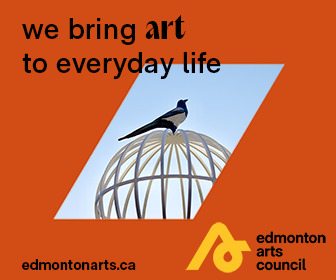
6 notes
·
View notes
Text
Indigenous Framework Art Collection unveiled at City Hall
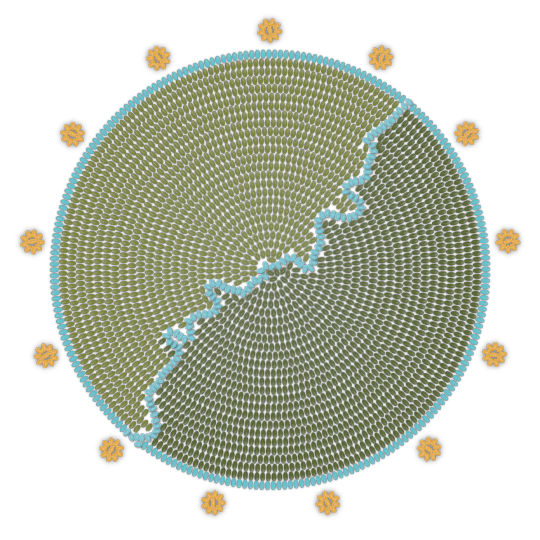
Indigenous Framework Logo by Tashina Makokis.
The City of Edmonton’s Indigenous Framework was built on years of dialogue with Indigenous communities, while seeking to answer the question, "How can the City of Edmonton best support and build strong relationships with Indigenous Peoples in Edmonton,” These conversations included formal and informal relationships with Elders, community Knowledge Keepers, and Indigenous youth, as well as information gathering from research and discussions with municipal and community leaders, service providers, and academic professionals.
In 2019, Indigenous artists Melissa-Jo (MJ) Belcourt Moses, Brad Crowfoot, Dawn Marie Marchand and Lana Whiskeyjack were invited by the City of Edmonton to capture the spirit of the Indigenous Framework community conversations and tell a story through creation of a visual art piece. The collection of completed artworks embody how City leaders and staff should strive to honour the spirit of kinship, the Indigenous Framework roles and commitments, and how to be a good relative to each other and to the land. The public display of the Indigenous Framework art collection in City Hall is a direct response to the Indigenous Framework, Truth and Reconciliation Commission and MMIWG2S+ commitments and actions to ensure the resurgence of Indigenous cultures and histories in city spaces.
As the artworks are unveiled at City Hall, we asked the participating artists and Jaimy Miller, Director of Indigenous Relations at the City of Edmonton, to reflect on their work and what it means to be involved in this project.
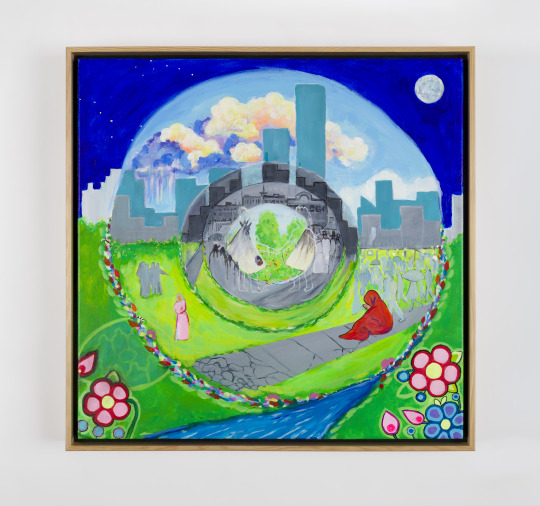
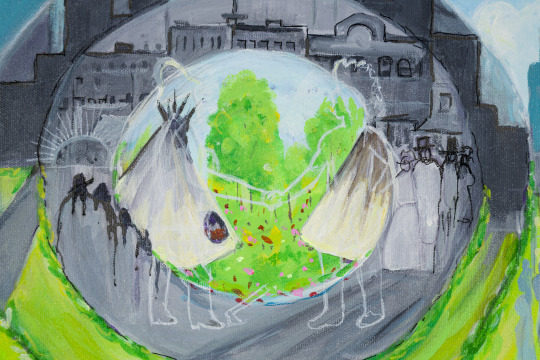
PISISKAPAHTAM (to notice and observe or watch) by Lana Whiskeyjack. Photos by Dwayne Martineau.
Your artworks were all inspired and informed by the results of the community engagement process for the Indigenous Framework. What about that process and what you learned, made its way into your individual work?
Lana: As the community members gathered to share about PISISKAPAHTAM, I listened and responded through live painting. Their stories of cultural memories braiding in their experiences of racism, violence, and poverty in the city provoked my experiences as nehiyaw iskwew. Our collective stories were translated through the colours and images.
MJ: I started my art piece just prior to Covid–19. Feeling the pressure to get it finished, I asked my niece Bella Stonehouse to sort beads for the 14 rows. Time was limited, so my friends Debbie Houle and Sherryl Sewepagaham offered to thread beads. Half-way through the threading and stitching, news of Covid struck and we were forbidden to be in close quarters. My social work-bee came to an end. Sheryl brought me some toilet paper, and with masks to cover our faces, we bumped elbows goodbye.
Under the strains and confines to the Covid outbreak I learned that my strongest ties to the Indigenous arts community emerged from my long-standing connections and friendships.
Overall connection to community is the significance that comes from the creation of the art itself, people coming together, assisting, and contributing what they can do to complete the work. Though we were not able to meet, I still felt supported and encouraged to complete my piece.
Dawn Marie: I recreated the facilitation notes and flip charts of the community engagement process. When I looked at it, I looked for themes and recurring statements until the structure presented itself. It’s all their words just reorganized. Upon reviewing all the support materials, it was clear that the conversations at the various tables centred around four main themes; financial support, staff/training, ombudsman/advocacy office and culturally safe space/s.
Several symbols such as horses and hoof prints symbolize concerns and barriers brought forward by Indigenous community members like financial support and sustainable funding. The movement of horses, for example, represents how the City must collaborate with Indigenous communities in Edmonton to ensure actions reflect diverse voices and perspectives. Other symbols like the circles represent the need for continuous education and training and self-reflection of personal beliefs, attitudes, and assumptions leading to action against racism towards Indigenous Peoples. The intent of the artwork is for City staff to put these teachings into practice in the workplace. For a deeper understanding, there is an artwork guide on the City’s Indigenous Framework webpage.
Brad: One of the themes that came out of the community engagement was Treaty. One point made was, Treaty was the original framework, and this inspired me to use the kohkum scarf and the colours: yellow, blue and green. For as long as the sun shines, the river flows and the green grass grows. We are all treaty people.
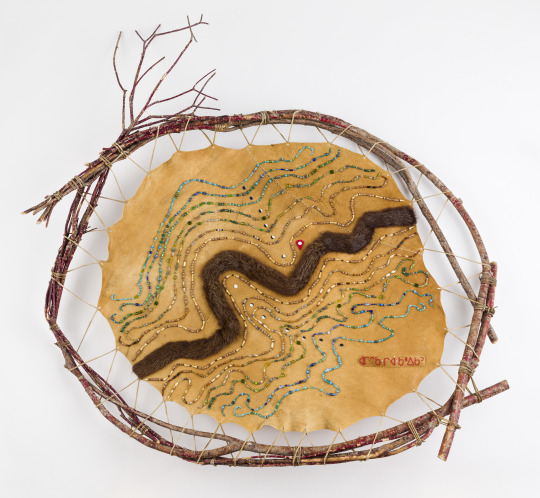

ᐊᒥᐢᑲᐧᒋᐋᐧᐢᑲᐦᐃᑲᐣ Amiskwaciy-wâskahikan by MJ Belcourt-Moses. Photos by Dwayne Martineau.
What does it mean to you as an artist to have your artwork on display in City Hall?
Lana: As a nehiyaw iskwew visual storyteller, my intention is to contribute to the diverse decolonial stories of courage for our future generations. To have the municipal leadership collectively agree to provide City Hall walls to carry the collective visual stories of Indigenous peoples is an act of reconciliation.
MJ: It’s an honour and a privilege to represent my ancestral ties through a creative lens that ties me to land. Presenting my perspective to a wider audience about our relationship to land and stories connect us to where we are from and who resides within these parameters. We are here, tied to place we call home ᐅᑳᐁᐧᒫᐊᐧᐢᑭᕀ [okâwîmâwaskiy] -- mother earth. It is my hope that the 7th generation still has beauty to breathe deeply in.
Brad: For someone who was born and raised in Edmonton and to see City Hall host numerous events and have many very talented artists on display and their work showcased. I feel honoured to be apart of them and to see my work alongside the other artists who contributed to this project. It gives you a feeling of validation as an artist.
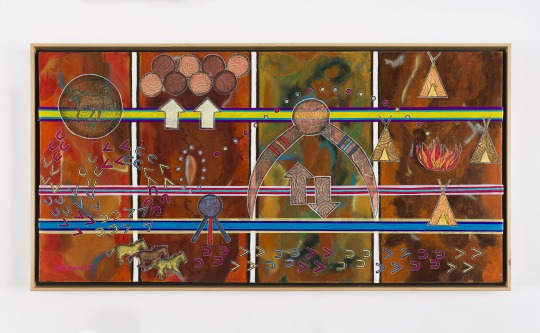

City as an Advocate by Dawn Marie Marchand. Photos by Dwayne Martineau.
What message about the Indigenous Framework do you want to share with our arts and cultural communities?
Lana: The amount of mental, emotional, and physical labour to collect, share and mobilize these stories of Indigenous relatives is a great gift to the city. I am proud to live in a city that listens and governs with action to create good relations for our future generations.
Dawn Marie: I’m grateful that there was a well-rounded engagement process.
MJ: Connection is vital... get to know each other. Go to an art exhibit, buy some Indigenous art, listen/read Indigenous storytellers, have tea with an Elder. If we are visitors to these lands or if this is the land of our forefathers, we must show respect for the giving and sharing.
Brad: My art piece has bit of the past with the kohkom scarf, a symbol of how Indigenous peoples adopted the Ukrainian scarf as their own showing great respect towards the Ukrainian community. Parts of the present with the Beaver Hills House Park art installation shows the City of Edmonton working with Indigenous communities to showcase our art in public displays. I added the seven teachings, to look into the future with an Indigenous lens if we want true reconciliation.
Jaimy: The Indigenous Framework was developed through a co-creative process with community members, organizational partners, and Elders, youth, and artists. Working with Indigenous artists presented a wonderful opportunity to capture the intentions, the feelings, and the statements of community in a visual representation. Their artwork is a reflection of community, of our city, and speaks to the four roles that the city of Edmonton is striving to live out - to be a listener, a partner, a connector, and an advocate and to build positive meaningful relationships with Indigenous peoples in Edmonton.
One of our commitments in the Indigenous Framework is to create safe welcoming spaces for and with Indigenous people, and to ensure that Indigenous communities see themselves reflected in city spaces and places. Art plays a fundamental role in creating a sense of place, identity, and connection to community.


Heart Beat of a Nation by Brad Crowfoot. Photos by Dwayne Martineau.
Is there anything else you wish to share?
Lana: Please be a better relative. Nohkom would say, “Speaking, walking, talking and supporting with kindness is one the best ways to being a better human.”
Dawn Marie: Thanks for the chance to show alternative ways to knowing and showing story.
Brad: I would like to thank MacEwan University for this opportunity to be involved in this project. Even the community engagement was held there, where I met and listened to what people had to say. I included the Poundmakers Singers, a photo that was taken as they sang for MacEwan’s unveiling of their Treaty 6 marker.
Jaimy: I am so thrilled to see these artworks have a home in City Hall and be displayed for all Edmontonians and all leaders now and in the future that will walk through these halls. I hope that people will take the time to view the art and reflect on the gifts of the artists, and the messages within their art. And of course, I encourage people to read the Indigenous Framework at edmonton.ca/indigenousframework
About the artists
Lana Whiskeyjack
Dr. Lana Whiskeyjack is nehiyaw iskwew (Cree woman) scholartist (scholar and artist) from Saddle Lake Cree Nation and is an associate professor in the Department of Women's and Gender Studies in the Faculty of Arts, University of Alberta. Dr. Whiskeyjack demonstrates innovative interdisciplinary knowledge translation and mobilization through arts-based practices, community-engaged research, scholarship services and teaching. As a graduate from the first Indigenous governed educational institution in North America and former Indian Residential School, in the iyiniw pimâtisiwin kiskeyihtamowin doctoral program at University nuhelot’įne thaiyots’į nistameyimâkanak Blue Quill, she has an excellent record of research/creative dissemination that is grounded within nêhiyaw (Cree) ceremony, nêhiyawêwin (Cree language) and nêhiyaw worldview.
Dawn Marie Marchand
Dawn Marie Marchand is a member of Cold Lake First Nation in Treaty Six territory. cîpêhcakwawêw-iskwêw (Blue Horse Spirit Woman) is a Cree and Metis artist, educator, advocate, author, writer, speaker, and mother. Her many noted accomplishments include Circle of Courage Coordinator for the Alberta Indigenous Games in 2011, Co-founder and lead organizer of Cree8 Success Conference in 2012, art installations for the Edmonton Folk Festival in 2013 called “Monto”; Edmonton City Hall in 2014 during the Truth and Reconciliation Gathering “A Place to Hang your Stories”; co-producing the Walrus Talks-Aboriginal City art components in 2015, “Edmonton Treaty 6 Soccer ball”; and Redx Talk “Art is the Medicine” in 2016; and an installation called “The Longest Journey” as part of the Nuit Blanche Festival in 2018. She received an Aboriginal Role Model Award for Art in 2017, during her term as the First Indigenous Artist In Residence for the City of Edmonton, facilitated the Indigenous Artist Market Collective engagement and launch in 2018. In mid 2019, she relocated to Smoky Lake, AB. Since then she has had work installed in Concordia College, Indigenous Knowledge and Research Centre, Stanley Milner EPL, PÎYÊSÎW WÂSKÂHIKAN. She has had her work projected as part of Dreamspeakers Light Strikes in numerous locations including Dubai and has recently had work projected as part of the Land Acknowledgment during the Junos celebrations in 2023. She was the artist consultant for Punctuate! Theatre's "First Métis Man of Odessa" which is currently touring nationwide. She continues to advocate for removing systemic barriers for Indigenous artists across Canada.
MJ Belcourt Moses
MJ is a traditional Métis artist, certified Native Cultural Art instructor and most recently served as Indigenous Art Consultant for Fort Edmonton Park and Indigenous Curator for the Edmonton Public Library. In 2019, MJ served as an Indigenous Artist in Residency with the City of Edmonton.
“I have a keen interest in the promotion and education of Indigenous Arts that relate to our cultural life locally, provincially and nationally… Indigenous People rich contribution to Canada’s history and heritage reflects perseverance, strength and resilience - Art celebrates the achievements.”
Brad Crowfoot
Brad Crowfoot is a Blackfoot and Navajo multi-media artist, born and raised in Edmonton. He’s been active within the arts scene for almost 20 years and is known for capturing Indigenous arts, culture and entertainment through photography and digital media. He went to school for Arts and Cultural Management at MacEwan University and was involved with kihêw waciston as part of the Indigenous Student Council Executives. He got involved with the City of Edmonton and the Indigenous Framework to help showcase the City as a partner.
3 notes
·
View notes
Text
I Am YEG Arts: Heather Shillinglaw

Mixed media artist Heather Shillinglaw expresses her Indigeneity and familial oral histories through collages that employ sewing, painting, and sculpture methods. She grew up in Ministik near Cooking Lake and now lives in Edmonton and has a strong connection to the land and to her heritage; Nêhiyawêwin /Cree, Dene/Chipewyan, Salteaux/Ojibwe, and Scots/French. Over the course of her career, she has shared land-based teachings in art workshops with thousands of students of all ages, taken on activist work to highlight the importance of the natural world to inspire others to preserve what is left, and has exhibited her work extensively. In this week’s I Am YEG Arts feature, we get to know more about Heather Shillinglaw.
Tell us about your connection to Edmonton and why you've decided to make it your home.
Growing up outside of Edmonton, we would come into town to do our shopping, and all that kind of stuff. And I always thought it was so fancy, and a fantastic place to live with all these great shops and beautiful river valley to pick berries or whatever. It maintained a consistent interest for me to live here and settle here. Now that I have my family, my husband and my two daughters, we call it home. And it's not far from the place where I grew up, and my family. So, we're kind of surrounded within Edmonton. I also have an ancestral connection to the land in that they harvested medicines, mostly berries here, which I'm very glad to say that saskatoons grow prevalently in our River Valley.
What is your creative process like? And what motivates you as an artist?
I started out mostly as a mixed media artist, project based, so when I make art, I'm very material based. There's kind of a relationship with the material that I start building a language within the work I'm creating. It's either through symbolism, the materials, or the project base -- the goal -- which is talking about the environment, preservation of what's left, to creation of the piece itself. Right now, I'm obsessed with sewing, and I'm sewing on hides and then I'm sewing on big florals. I collect and harvest like a mouse. That's my animal spirit and I see things large and giant, and I'm very humbled by the land.
In my pieces I’m using anywhere from three to six different types of sewing machines to create the work. When I'm sewing, I'm thinking about that kinship and relationship to the landscapes, like the maternal landscapes. It's all nature based and it's all about the healing plants and medicines that are in our land.
How do you choose the materials you work with?
That's a tricky one because I'm constantly collecting like a mouse. Another aspect in thinking about conservation of our land and not causing problems, I use a lot of recycled materials and mediums. In the body of work that I'm still creating, ᒫᒥᑐᓀᔨᐦᒋᑲᐣ ᑯᑖᐄᐧᐤ mâmitonêyihcikan kotâwîw, – my mind digs in the soil like a turtle -- an exhibition that's happening right now in Halifax at the Mary Black Gallery -- I'm sewing on to hides and it's kind of an eagle eye’s perspective. Through that I'm doing tufting, beading, and sewing into bodies of water that relate to the landscapes of where my ancestors hunted and harvested. Inspiration sources come from here, there and everywhere. So, you know, I'm a mouse that acts like a magpie.

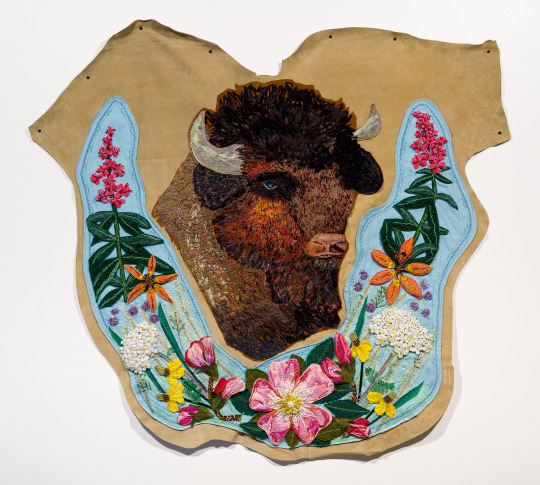
Top: Detail of ᑮᓯᑌᐳᐃᐧᐣ ᓵᑳᐦᐃᑲᐣ kîsitêpowin sâkâhikan cooking lake by Heather Shillinglaw. Bottom: Gravemarker Bison from the Whiskey Script Series by Heather Shillinglaw.
Where does your inspiration come from?
The inspiration comes from the land itself. For a lot of my projects, my inspiration source is my mother: through storytelling about the land, and her memories from our Nohkums, our grandmothers, and how they harvested from the land, right down to the specific berries, or the relationship that the moths share with the trees and how it provides a kinship relationship to the land itself. Then through that, I'm taking oral stories and I'm also looking at other forms of research, such as archival research. I've worked with ethnographer Ruth McConnell and I've been working with Elder and Knowledge Keeper Lynn Desjalais/Lush from the Sandy Bay Reserve (she's a relative of ours, I think that's an added bonus). And Anne Cardinal, who's from Saddle Lake Reserve. There's a cultural connection, an artistic connection, a research base. So, there's many different platforms in my resources and where I make my art from.
Marilyn Dumont is another source of inspiration. Marilyn is a Métis poet, and we share common lineages in where our inspiration sources come from. I've been sewing her poetry into bodies of water, and I sew my own poetry now because she's given me a lot of strength to do that. So that's another aspect of my work – using poetry and prose to talk about what's going on in the art. I'm so honoured that she said she's willing to work with me and we continue to work together on projects.
You've had the opportunity to exhibit your work nationally and internationally as well as participate in residencies abroad in Paraguay and Argentina. How was your artistic practice influenced by these cultural exchanges and how was your work received?
That was so much fun. 2009 was a bit of a banner year for me. Beatriz Ventura , who is the Canadian consulate located in Buenos Aires, for Argentina and Paraguay, connected with me and we talked about medicines, and she talked about her ancestors and how they hunted and harvested. Through that I sat on panel discussions, I exhibited my work, and then I did a little bit of a residency. I was quite excited and engaged by what was happening with the Indigenous people out there and how it was almost like going back 200 years for their discovery of the oil rights in the land. I gave some advice, from my ancestors and their trauma and problems that we've had in the past. I got invited to go around with an anthropologist in Mendoza and she took me up into the mountains, and we met the Indigenous tribes there. It was a phenomenal experience.
The more I thought about it, the more I wanted to talk about plant sustainability, which is in my practice today. Then I got invited by a conference attendee from Paraguay, Asunción to stay in her home. I got a chance to meet all these wonderful people there, networked with them, created workshops for the conference that I attended, gave a panel discussion presentation of my work, and then I also got a chance to work with the UNICEF school out there as well. I kind of became a little bit of a political activist. I'm not in your face in my politics; there are political statements within the art itself. And the more I create my work, the more I'm concerned about the land and preservation, because our oil and gas industry is affecting our water tables, it's in our system and there's some relationships of what Industry Canada is doing to our land that is very disconcerting. As an artist, your job and your role is to make sure you carry your message through your art, so that's where art becomes an activist statement. And I don't want to be in your face. I want people to want to understand. And that's where you can access more of a deeper, profound way of understanding the art, understanding culture, and understanding our planet and preservation.


Top: Gravemarker Fox from the Whiskey Script Series by Heather Shillinglaw. Bottom: Painted Red by Heather Shillinglaw.
What would you say is your greatest strength as a creative?
I have taught many artists and residencies over the years, and I worked at the Art Gallery of St Albert as their first Indigenous Visual Arts Programmer; I take pride in that. Whenever I'm teaching, I take it upon myself to inspire people. That’s important and supports my practice. That's another hat that I wear as an artist. Through my Elders, I've learned that a big part of our culture is sharing, and you share with humility. Like, the information that was given to me, you hand it down for the next generation to inspire them. And they're probably not going to make the same work that you're going to make; the goal is to inspire, and that’s why I teach.
Tell us a little bit about what you're currently working on or hoping to explore next.
At the Centre of Contemporary Craft of Nova Scotia there is an exhibition of my work right now, it closes on July 2nd. I will be going to see the exhibit and attend a series of things going on out there. It’s a body of work called ᒫᒥᑐᓀᔨᐦᒋᑲᐣ ᑯᑖᐄᐧᐤ mâmitonêyihcikan kotâwîw, – my mind digs in the soil like a turtle, and it's basically large landscapes and a body of work that showed here last year at the Alberta Craft Council. It does come back here in the fall, in September and October at the Art Gallery of St Albert. We're going to be doing some exciting activities, workshops and talks.
In January, I have an exhibition at the McMullen gallery. I'm going to be doing some workshops and artist talks and events. And as a sneak peek, for Gaagige Giizhig - Ishpeming (Forever Sky) (the Sky Above) I'm going to be turning the gallery to space! Those are works are on black panels, and there's thirteen of them, and they're not small either -- some of those panels are larger than me, so maybe like 8' x 5’ ft. MSHKAWJI GIIZIS (FREEZING MOON) – OCTOBER for example, is one of them, it’s the frost moon, so they're really different.
And then I have another body of work, it's called Whispers in the Forest, and it's going to the Esplanade Gallery [in Medicine Hat]. It's part of a larger group exhibition. In 2026, I have a solo exhibition at the same gallery and I'm just working through that. I'm going to be focusing on learning ancestral languages from language keepers: Saulteaux Denesuline language, Anishinaabe language, and Nêhiyawêwin Cree. It's going to be a massive mouse trap, a life-size mouse trap that focuses on live, eat, sleep, repeat.

Detail of MNIDO GIIZIS (SPIRIT MOON) – JANUARY by Heather Shillinglaw.
Tell us about a local artist group or organization that is doing great work in the community that you think more people should know about.
I would start off by saying CARFAC Alberta is fantastic and great to work with because they do a lot of programming to help artists survive as artists. There's a lot of versatility in the art world, but it's challenging to survive as an artist. They do all kinds of workshops to help people, anywhere from writing grants, to what's next, or how to ship your art internationally and that sort of thing. So, there's lots of opportunities for artists to learn from them.
And then I would say the Art Gallery of Alberta is fantastic. I’ve shown my work there, I sell my work at the art rental sales, and I've had opportunities to work with them and be a special guest artist, teaching workshops for them that a benefactor had paid for. There are phenomenal opportunities for artists to connect with them. Outside of that, there is the Art Gallery of St Albert. Emily Baker and Leah Louden are fantastic. They also sell my work out there, and they do amazing programming that is so unique. You can go in by donation and still access a lot of the arts just in that space itself. So those are some really good places that do so much in the community.
The Rowles and Company Gallery also sells my work. I'm saying support our local galleries because you know, they really struggled to get through COVID, so it's really important to share that message with others.
And I didn't even mention the Edmonton Arts Council, that they offer so much programming, so many grants and possibilities for artists themselves. I've been honored to be a recipient of those grants and organizations for money to create my works.
I am also so thankful that I have been inspired by Shirley Norris Shillinglaw, who's my mother, and my family that supports me. Keith Macmillan and my daughters tolerate bits of thread and my messy nature. They’ve been very generous to allow me to do that.
About Heather Shillinglaw
Heather Shillinglaw is a project-based artist adapting art materials using sewing, painting and sculpture methods. Growing up in Ministik near Cooking Lake, she now lives in Edmonton, Alberta. Shillinglaw is proud of her heritage; Nêhiyawêwin /Cree, Dene/Chipewyan, Salteaux/Ojibwe, and Scots/French. Shillinglaw shares land-based teachings in art workshops to thousands of students of all ages, throughout her career. She becomes an activist, her voice in sharing through art she hopes to inspire the importance of the natural world to inspire preserving what is left. Exhibiting her work nationally and internationally, she is humble in acknowledging the awards and Grants that help her projects, inclusive of a recent award Leighton Studio stay at the Banff Center for the Arts; the Gerin-Lajoie Studio. Previous exchanges abroad in Paraguay and Argentina working with anthropologists, medicine women of Tobian- Guarani and Mapuche healers in South America, and other shows/cultural connections abroad. You can learn more about Heather here.
3 notes
·
View notes
Text
Happenings on Churchill Square
Churchill Square programming is in full swing with an array of free, family friendly special events coming up in May and June. You can also catch our regular free weekly programming which includes Live at Lunch, Zumba, Salsa on the Square, Cypher Wild and the crafts with the AGA Art Cart. Check out our roundup of upcoming events below:
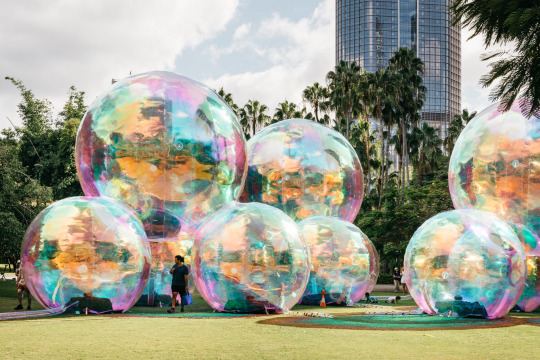
Downtown Spark
Get ready for whimsical art installations from around the world, family-friendly fun, concerts, dance parties and more! Starting this week, explore large-scale art sculptures throughout the downtown core at Downtown Spark. From May 25 to June 4 giant art installations will be located at six different locations, with the largest piece Evanescent by ATELIER SISU coming to Churchill Square. Edmonton is the first city in Canada to host Evanescent, after appearing in 22 international cities and 12 countries. There will also be FREE lunch-time programming, with local musician Aladean Kheroufi kicking things off with a live performance at CKUA on May 25 from 12 – 1 pm. For more information visit https://www.edmontondowntown.com/spark/.
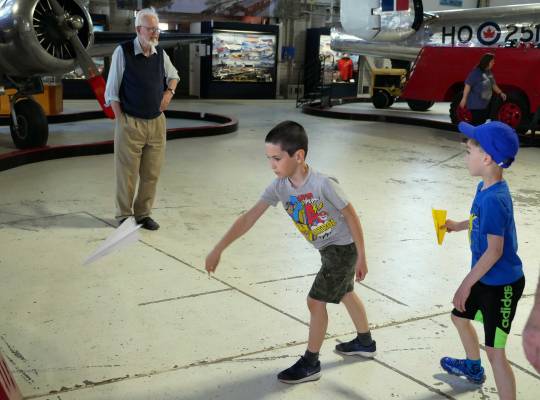
Paper Airplane Day
Did you know that May 26th is Nation Paper Airplane Day? The Alberta Aviation Museum will be bringing their Paper Airplane Test Lab to Churchill Square on Friday May 26 from 12 – 2 pm where you’ll have a chance to build different airplane designs and compare what makes them great at tricks and skills. There are designs for everyone from beginners to the paper airplane pro, or you can put your own designs to the test. Staff will be on hand to help fold and decorate your airplane, then it’s up to you to let them fly!
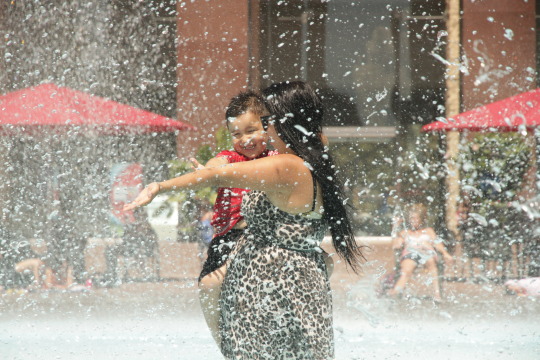
Splash Day
Come down to Churchill Square and beat the heat! On May 27th the City of Edmonton is turning on the fountain in front of City Hall, and we’re marking the occasion with Splash Day. Join the EAC and the City of Edmonton from 11 am – 4 pm for performances by the Tsunami Brothers and the Trincan Steelpan Orchestra, roving sea creatures, food trucks, games and more.
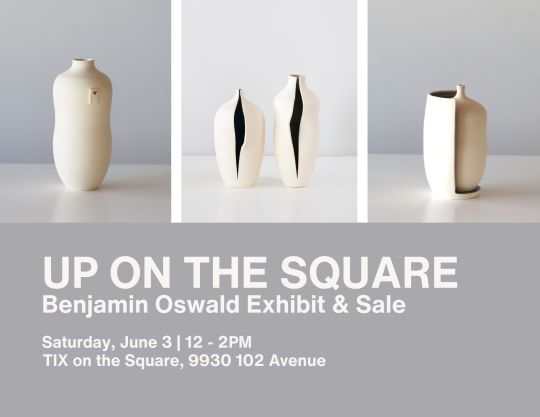
UP on the Square: Benjamin Oswald
Stop by TIX on the Square between June 3 –17 to find a selection of work from Benjamin Oswald's residency, the unveiling of his City Marigold collection and many other surprises. Many of the ceramic pieces on display were created with glazes developed with the support of a recent EAC grant. Select items will be available for purchase.
Benjamin Oswald has shown and sold his work in multiple spaces in Edmonton and beyond, including Latitude 53, AGA, TIX, the Artworks and Studio 21 Gallery in Halifax. Through a project with TIX, Benjamin was commissioned by the City of Edmonton to create a special collection which references our civic flower, the marigold. He recently returned home from a residency in Denmark, where he experimented with new forms, glazes and forms.
Opening Reception: June 3, 12 - 2 pm, exhibit runs: June 3 - 17.
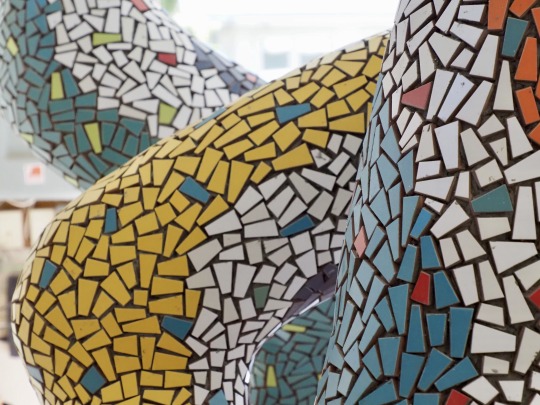
New child-friendly public art
Have you spotted the new artwork being installed on the Square? Created by local artists Erin Pankratz and Christian Peres Gibaut of Red Knot Studio, A Mischief of Could-be(s) consists of five standing sculptures, drawing inspiration from how children freely interpret and imagine the world through play. The tree-like quality suggests the idea of a magical forest, while the ambiguity of the forms allows for other interpretations, such as tentacles, snakes, arms, stalagmites, etc. The whimsical shapes and colourful palette make the art engaging for art lovers of all ages. To celebrate the installation of this new public art, the EAC will be hosting a kid-friendly celebration with the artists. Keep your eyes peeled for more details in the coming weeks.
Please note that all events are dependent on weather and air quality. Be sure to check the EAC's social media and website for updates about cancellations.
#yegarts#yeg#edmonton#edmontonarts#publicart#yegartists#yegmusic#community programming#churchillsquare#yegdt
2 notes
·
View notes
Text
I am YEG Arts: Ray Dak Lam

Since taking the plunge into freelancing, Ray Dak Lam has made big waves as a graphic designer and illustrator. Known best for his signature geometric designs and vibrant colour palette, Ray is sought after locally and internationally with some big-name clients under his belt. In just a few years as a freelancer, Ray has embraced new opportunities from his first mural project to taking part in Adobe’s Global Creator series — this week’s I am YEG Arts story puts the spotlight on Ray Dak Lam.
Tell us a little bit about yourself and about why you’ve made Edmonton your home.
I'm an illustrator and designer from Edmonton. I graduated from the MacEwan Design Studies program in 2014. I got my creative career started working at a couple of advertising agencies and at a smaller design agency. Since then, I’ve become a full-time freelancer — that's what I've been doing for the past few years. I really like the creative freedom of freelancing, and that I get to explore more of my own personal style as well as choose my own clients and hours.
I was born in Edmonton and have lived here all my life. All my friends and family are here, I feel like Edmonton will always be my home. Edmonton has also shaped who I am as an artist in many ways — the people, especially those I went to school with and have worked with, all my coworkers, friends and experiences growing up — I think it all inevitably influences the subject matter in my work and the themes that I introduce into my illustrations. And now I hope to contribute what I can to the city's creative culture.

What drew you to graphic design and illustration? How did you get your start?
During my first year of high school, I took a graphic arts program, and my very first project was to recreate a font or typeface. It was through typography that I discovered my love for graphic design. And that's when I began considering it as a career for myself.
As for illustration, drawing has always been part of my life. I was always drawing as a kid, and I was never really good at any other subjects in school. Art was the only subject that I was passionate about. It is what motivated me and pushed me to pursue it all through childhood until now.
Tell us about someone who mentored you or helped set you on your path.
One of my first mentors was Andrew Benson. I worked with him at my first job at an advertising agency. He taught me a lot about branding, design, and the advertising industry in general. He’s passionate about print design and illustration and taught me their importance when it comes to design. He really inspired me when he went off to start his own studio and I hoped for myself I could follow in his footsteps.

Tell us about a big professional risk that you have taken and how it has influenced where you are today.
I would say taking the leap into full-time freelancing. It was scary in the beginning. I got laid off during the beginning of the pandemic from my advertising agency job. And at least for me, it was hard to find another full-time position. I was only able to land various short-term contracts, and some freelance projects here and there. In that moment I saw it as an opportunity to try this freelancing thing full-time since it has always been a dream of mine.
The pandemic and getting laid off were the push I needed to take the full leap into freelancing. It really changed my career for the better and it has opened up a lot of opportunities that I never would have thought possible. I have had a chance to work with and collaborate with a lot of clients that I had thought were unattainable. And I’ve gotten to collaborate with many other incredibly talented designers and creative people in Edmonton.
Who's someone inspiring you right now?
Someone who is really inspiring me right now is an illustrator from Vancouver, Tom Froese, he makes Skillshare courses, through which he teaches his approach to commercial illustration; YouTube videos, podcasts — all on the topic of illustration, and aimed at people interested in the creative industry. I've done a couple of his Skillshare courses and I'm attending one of his workshops at the RGD DesignThinkers conference coming up May 30 -31 in Vancouver.
He inspired me to find a focus and explore it as deeply as I can. His style has a very distinctive voice and he mentioned in his videos that it was the result of repeating a set of techniques over and over again once he found something that worked for him, so this really inspired me to seek a similar path for myself in terms of finding my own unique stylistic voice.
What does your creative process look like? Where or how do you usually begin?
For me, it always begins in my sketchbook. I try to bring my sketchbook with me anywhere and everywhere I can. Especially when I'm traveling, during those long plane rides and train rides where I can just let my mind wander and draw freely — whatever comes to mind. After that I pick my favorite sketches and vectorize the artwork, then bring it into Photoshop where I use my drawing tablet to add texture to bring more of my own personality to the artwork.
I enjoy creating abstract and geometric compositions because it's a meditative and calming process for me. I started a personal project during the pandemic called "Shape Studies", and it's been an ongoing project ever since. With a focus on the fundamental elements of shape, line, and colour, I explore freely within those basic fundamentals to create the most interesting compositions that I possibly can. I also use similar principles of geometry and abstraction when I'm illustrating other subject matter, such as animals, landscapes, people, etc. I'll continuously remove any unnecessary details and distill them into their most essential and fundamental forms.
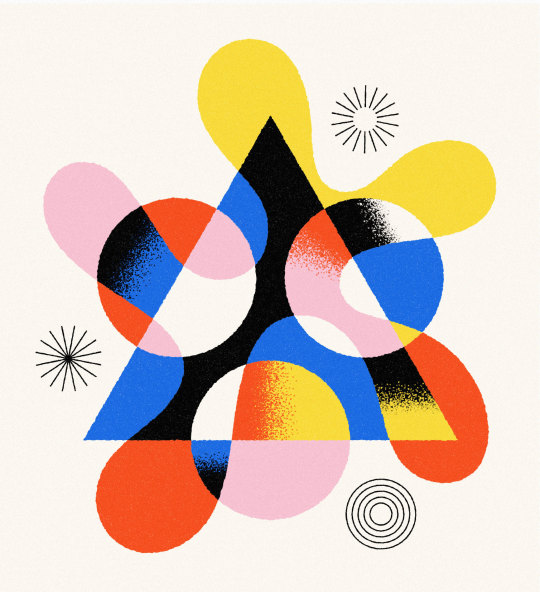
Tell us about one of the most exciting projects or opportunities you've had.
One of the most exciting opportunities I had last year was the chance to collaborate with Adobe on their Global Creator series. It was a series where they featured different artists from around the world and they decided to feature me. They had me self-shoot a ton of footage around my studio, capture shots around Edmonton, and create a short tutorial explaining some of the techniques that I use to create my illustrations.
It was both exciting and nerve wracking appearing on video, but I'm glad I did the project because I love the way it turned out in the end.

Tell us about a favourite local project and a favourite international project.
One of my favourite local projects was for Doughnut Party. They had me create a mural for their Ritchie location. I collaborated with Jennifer Konanz — she's a local mural and sign painter. She's incredibly talented and I feel grateful to have collaborated with her. She helped translate my artwork into a large-scale mural. It was really cool to see my artwork on such a large scale, which I don't get to see very often.
A favourite international project would be a commission for GoDaddy to create a set of illustrations centered around Asian Heritage Month and Lunar New Year. The project was really special to me because I got to express my own cultural background and upbringing as an Asian Canadian. Also, it was fun to illustrate dragons and dumplings in my own style.
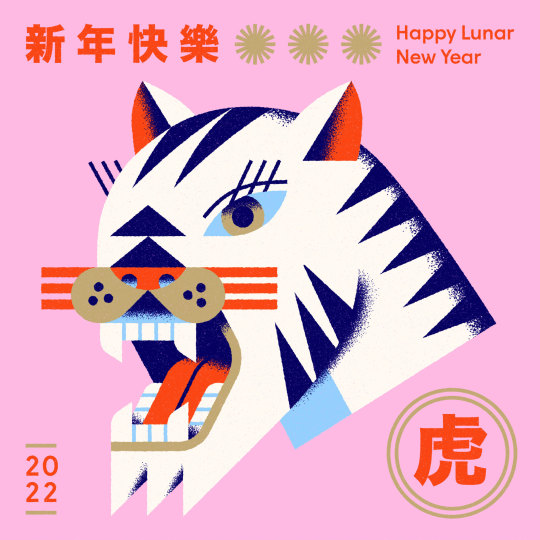
What are you currently working on and what do you hope to explore next?
I've just completed the 36 days of type challenge on Instagram yesterday and it was really satisfying to see it through from start to finish! The project invites designers, illustrators and artists from all over the world to create a letter or number each day for 36 days straight. It was my first time taking part in the challenge. I really love to explore creatively, and I feel it’s important to work outside of client deadlines and budgets. It’s somewhere I can freely express my voice and craft and refine my style.
It was great seeing all of the other work from artists and designers that I follow, as well as discovering new artists to follow. Freelancing can be isolating at times, so participating in this challenge made me feel like I was part of this larger community all undertaking this daily activity together.
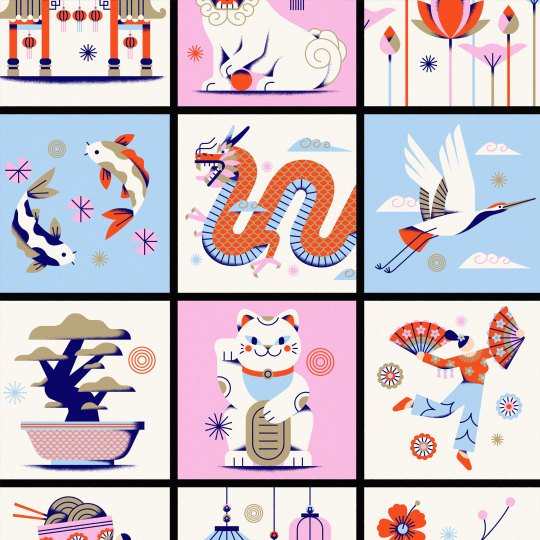
What excites you most about the Edmonton arts scene right now?
All the projects centered around Edmonton's Chinatown like Chinatown Greetings, created by Emily Chu and Shawn Tse, and Jordon Hon’s A Portrait of Chinatown documentary series. And many other creative projects that are supported by the Chinatown Transformation Collaborative (CTC). All these projects play a really important role in the revitalization of Edmonton's Chinatown. It's really inspiring to see so many people from different creative backgrounds coming together for a common cause.
Want more YEG Arts Stories? We’ll be sharing them here and on social media using the hashtag #IamYegArts. Follow along! You can keep up with Ray on Instagram, Behance, Dribbble or visit his website.

About Ray Dak Lam
Ray Dak Lam is a designer and illustrator from Edmonton, Canada. His work is characterized by its simplicity, utilizing vibrant colours and bold geometric forms as the basis for direct, communicative imagery. He works primarily on brand and illustration focused projects with clients around the world, such as Asana, GoDaddy, and McDonald's.
3 notes
·
View notes
Text
First SuperTrain artwork rolling out of the station

New temporary public art by local Indigenous artist Ambrose Cardinal is now gracing Edmonton communities along the LRT line. Ambrose created the new designs as part of the SuperTrain public art initiative led by The Society of Northern Alberta Print-artists (SNAP) in partnership with the Edmonton Arts Council and Pattison Outdoor Advertising. The multidisciplinary artist was commissioned to create new designs over a two-month residency rooted in the theme of “environmental stewardship,” during which he was encouraged to explore the relationship between the natural world and urban spaces.
His is the first of three SuperTrains. Later this year, collaborative designs by Michelle Campos Castillo and Roger Garcia will roll out in August; followed by Helen Gerritzen and Kyla Fischer in November. The three transitory public artworks will each provide a travelling public art exhibit for a span of at least eight months.
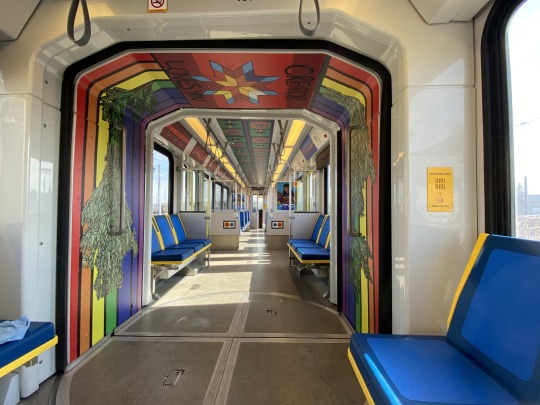
Ambrose Cardinal is a multidisciplinary Métis and Cree artist and Oskapewis (ceremony helper), hailing from Amiskwaciwâskahikan. The intersectionalities between his work as an Oskapewis and as an Indigenous artist revolve around expressions of radical love, resistance and healing. His most recent artistic interests are based around relationality to place, to honour the ones who currently inhabit space while also honouring our ancestors and connection to Amiskwaciwâskahikan. Art to Ambrose is essential to healing, essential to understanding and essential to creating a world worth fighting for.
“Environmental stewardship is ingrained into our beings as Indigenous peoples,” said artist Ambrose Cardinal, addressing the central theme of his work for the project. “The term carries a bit of weight – Indigenous peoples historically and currently have been systematically forced and disempowered from being the stewards of our lands. Even though this notion of being stewards of our lands was one of the original interpretations of treaty, we are not able to be these stewards, due to the active process of colonization. But it is our responsibility to reclaim our inherent rights to do so.”
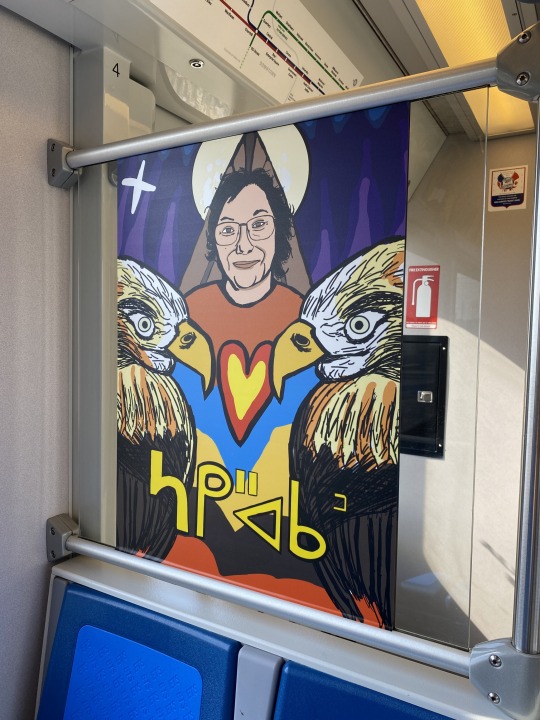
With this project Ambrose has important lessons to impart, “I want to encapsulate the interconnectivity of all beings that is entrenched within our spiritual laws as Nehiyawak. I want to utilize notions of traditional storytelling into the modern landscape of amiskwacy, to show that we have an active role to play in healing the earth and ultimately healing ourselves.”

5 notes
·
View notes
Text
I Am YEG Arts: Andrew Ritchie

Photo by Mat Simpson
Andrew Ritchie is seemingly everywhere all at once in Edmonton's theatre scene. His versatility as a theatre artist, whether he is directing or performing onstage, has taken Andrew across the country, but it is his ability to “build it yourself” here in Edmonton that has always brought him back. As Artistic Director of Thou Art Here Theatre and co-founder of the Found Festival (under Common Ground Arts), that DIY mentality has allowed Andrew to tell relevant and exciting stories in unexpected places while focusing on how space and the role of the audience can be explored in any theatre show. Director, theatre maker, improviser, program coordinator, teacher, producer – this week’s I Am YEG Arts feature focuses on Andrew Ritchie.
Tell us about your connection to Edmonton and what keeps you living and working here.
I was born and raised in Edmonton or amiskwacîwâskahikan on Treaty 6, and I am a third-generation settler of Scottish, Irish, Welsh and Polish heritage. My family originally immigrated to Winnipeg and rural Alberta, but we've kind of been in Edmonton since the 1980s or the 1950s, depending on what side of the family. And I've had the privilege to work across the whole country, including spending many years in Toronto, ON, but also in Regina, SK. But I've always been pulled back to Edmonton because this is where my community is. A lot of my personal family actually doesn't live here anymore, so it definitely is a place where my chosen family is. It's where my closest friends are, it’s where I've just found community among the people that practice theatre here, and I think -- especially after living in Toronto, which is a much larger city than Edmonton, then also in Regina, which is a much smaller city than Edmonton -- Edmonton feels kind of like the perfect size in between, and I feel like I can have a large impact in the city with my art. And there's also an ability to be DIY and to build it yourself here, which is kind of why I want to keep living and working here. Currently I work as the Program Coordinator with Theatre Alberta, I am the Artistic Director of Thou Art Here Theatre, I'm an ensemble member with Rapid Fire Theatre, and I'm also a freelance theatre artist.
How did you get started in theatre? Was it always plan A?
No, it was definitely not plan A, or B, or C, or D. My parents loved attending theatre. They were always patrons of the arts, so I think I was very lucky as someone growing up in Edmonton that I got the opportunity to see shows at the Citadel or at the Mayfield Dinner Theatre, or at the University of Alberta. And we'd go to the Fringe sometimes, or to the Street Performers Festival. But I was never really an artsy kid. It wasn't really until high school where I came across a lunchtime improv club, and through that I heard about improv that happened at 11:00 o'clock at night off Whyte Ave, which was Rapid Fire Theatre. I'd never heard of something like that before, and it was the coolest thing. This was in 2003 and I just fell in love with theatre. From that I did the Bachelor of Arts in Drama at the U of A, which eventually led me to graduate with my degree in theatre, kind of focusing on directing but kind of getting a handle on a little bit of everything from the BA program. And right after graduating, in 2011 I was part of a group that founded Thou Art Here Theatre, and also, I was part of a group of individuals that created the Found Festival under Common Ground Arts, and those two things happened roughly around the same time. And I think those kind of solidified my ongoing career in theatre.
What was one of the biggest professional risks that you've taken and how did it influence where you are today?
This was a tough one to think about. I think the biggest show risk I've ever taken was that in 2019 I directed and produced a production of Mr. Burns: A Post Electric Play by Anne Washburn, who's an American playwright. And at the time, I wasn't living in Edmonton and that show was just so large in scale. I think the artistic risks we took to transform the Westbury Theatre into three different theatre spaces for that three-act play, and the design elements, and the original music we wrote for the show, and just all those different parts that came together for the piece were just such a huge risk and I think paid off in the art. It was definitely a very challenging process, and I can look back on that and it makes me think of the grandiose vision of that and the aesthetic of that show that is something that I'm interested in continuing to try to find. And I think for me as a director, I think scale or spectacle with people, just having a lot of artists involved, is kind of something that I'm always interested in working on large scale shows, even when I have small scale budget. So that was a very big risk that I think I took that continues to influence me.
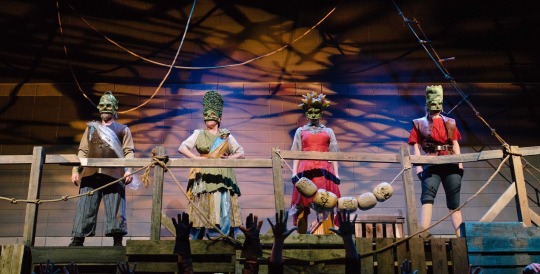
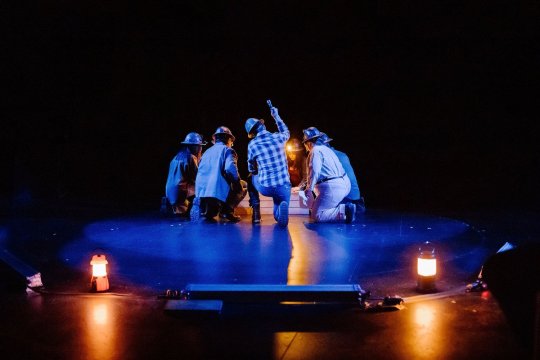
Top: Mr. Burns, a post-electric play by Anne Washburn. 2019. Directed by Andrew Ritchie, photography by BB Collective. Bottom: MINE by Ash Hicks. 2023. Directed by Andrew Ritchie, photography by Mat Simpson.
Tell us a bit about your role with Thou Art Here Theatre and what makes it special to you and the city.
Thou Art Here Theatre was co-founded in 2011 by myself and Neil Kuefler, who is a dear friend and a fellow graduate from the U of A. We both were emerging artists in the city and we, like many emerging artists, were very eager to work and we just weren't getting as many opportunities as we wanted. So, we decided to create our own opportunities and to produce shows in the spaces that we could get, which were free spaces, and I would say maybe sometimes “guerilla spaces” -- spaces that maybe you could ask for permission for, but we chose not to at that time. At that time, we were very interested in Shakespeare, being inspired by our professor David Barnett at the U of A. We were producing site specific, or “site sympathetic” Shakespeare shows that were engaging with the space.
That theatre company is so special to me. I still work with them today. I've come and gone from the company a little bit over the years, but really it represents friendship to me, like camaraderie. It's really hard to run a theatre company, but I think one of the reasons that Thou Art Here continues to exist, and a lot of the people that originally started it are still involved, is because we've always centered friendship at the forefront of it, and through that we’ve been able to take huge risks with our shows. We were able to tour a show to Calgary. We were able to collaborate with Freewill for the past eight years. And since 2011, the company has changed a lot. We are now a non-profit, and we just became a charity, and we also dropped the Shakespeare mandate so we are now less focused on the work of Shakespeare and more focused on how space and the role of the audience can be explored in any theatre show.
I think all theatre wants its audience to be engaged, of course, and I think when you break the rules that we understand about theatre, with how an audience may be is sitting, or they respond, or if they participate, I think it makes it much harder for the audience to disengage with the show. And I think it's more likely for it to be very memorable and hopefully an emotionally impactful experience.
Of all of your “site sympathetic” productions that you have created over the years, are there any particular standouts?
With Thou Art Here I think the one that we talked about the most in a certain nostalgic way is our production of Much Ado About Nothing by William Shakespeare, which we did three times. It had such a success to it, so three years in a row, and each year we kind of built upon it with the design of the show. We did it in 2014 and 2015 at the Rutherford Provincial Historic Site on the U of A campus, and then in 2016 we toured it down to the Lougheed National Historic Site in Calgary. And though many of the artists that were involved in the shows became close friends and it was a group of 10 actors, I found all three productions of those had ensemble. We found a beautiful sense of ensemble and I'm always trying to find that again.
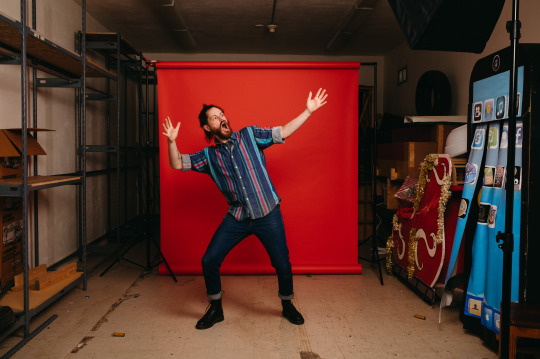
Photo by BB Collective
As a long-standing member of Rapid Fire Theatre, how does improv inform your creative process as a theatre creator?
I think it informs every part of it. I am constantly reminded of the rules of improv, or the tenants of improv. I am often working as a director or a leader in a space, and I think how I choose to have warmups in the space, how I approach rehearsal or teaching or directing, I want to embrace active listening, taking risks and that sense of play, which are all so important in improv. And I think continuing to act onstage and be in front of an audience can be super important for a director and makes them much more empathetic to the role of the actor and how an actor goes about the work that they do. So, I think it's all very tied together and I'm so very lucky to have performed as long as I have with Rapid Fire Theatre.
Who's someone inspiring you right now and why?
I recently had the fortune to travel to London, England and I saw a production of The Seagull by Anton Chekhov, directed by Jamie Lloyd who wouldn't be a household name, but this production starred famous Emilia Clarke. It wasn't Emilia Clarke that made this production inspire me -- she was great still -- but the overall design of the show and how it was they staged it, it really embraced simplicity. It took away any props or costumes. It was so contemporary to London and to the context there. It really just used people and theatricality. It was not naturalistic; it was using just chairs and bodies in space to create all the different environments. And I thought that was so refreshing and it was clearly not possible to do in film and I think that's such an inspiring thing to see in theatre.
And the other thing I just have to mention, are all my friends that are doing work in this city that inspire me. There's so many in the theatre community, but if I could rattle off a few, I am so inspired by my dear friends and their work: Geoffrey Simon Brown, Elena Eli Belyea, Gianna Vacirca, Oscar Derkx, Ainsley Hillyard, Lianna Makuch... there's so many. I'm inspired by my friends and community.
Tell us a little bit about what you're currently working on and what you're hoping to explore next.
So, I am currently developing a new solo show, my second show that I've ever created. It's called Cycle and it is all about urban biking and bike culture in Edmonton and in Canada. It's going to be exploring everyone's favourite two words: bike lanes. And I'd say it's hyper local, hyper political. It's also inspired by my time working as a bike food courier in Toronto and kind of talking about gig work culture and how biking can intersect with climate change and how we all have a right to move around our cities. So that's the show I’m currently working on.
The other thing I'm working on is that I'm about to have a second baby with my amazing, inspiring partner and wife Marlee in August. So that's kind of the next big life project.
If people are interested in learning more about any of the things I've talked about, you can go to https://thouartheretheatre.com/ or on all the socials, or I have a website andrewritchie.net and sometimes I post on Instagram, but not often.
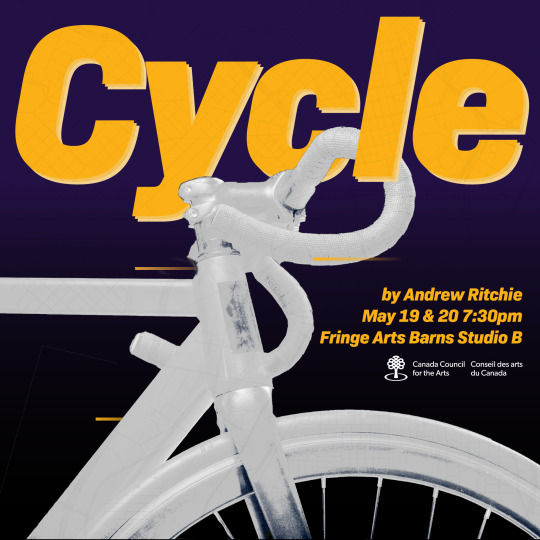
Promo for Cycle by Andrew Ritchie. Graphic Design by Tynan Boyd.
About Andrew Ritchie
Andrew Ritchie is a director, theatre maker, improviser, teacher, and producer born and raised on Treaty 6 territory in Amiskwaciwâskahikan (Edmonton). He has performed and directed across Turtle Island (North America) and his work has ranged from new work, contemporary, classical, improvisational, movement, mask, clown, bouffon, and immersive theatre.
He has a Master of Fine Arts in Directing & Creation from York University, a Bachelor of Arts in Drama & English with Distinction from the University of Alberta, and is a graduate of the Citadel/Banff Centre Professional Theatre Program.
Andrew is a co-founder and artistic director of Thou Art Here Theatre. He has performed improv across North America including being an ensemble member with Rapid Fire Theatre. Currently he is Program Coordinator with Theatre Alberta, an arts-service organization dedicated to the growth and development of the Albertan theatre community.
Previously he was the Sandbox Series Coordinator & Theatre School Director at Globe Theatre in Regina, SK from 2018-20. He is a co-founder of the Common Ground Arts Society's Found Festival, Edmonton's multi-disciplinary found space arts festival and was festival director from 2014-2015. He has ran two other indie theatre companies: Rock Steady Productions (2010-2012) & You Are Here Theatre (2016-2020).
1 note
·
View note
Text
Looking through the glass: If the Drumming Stops
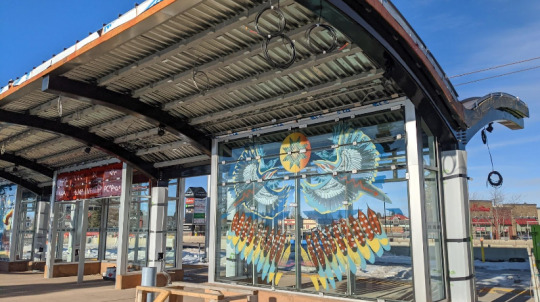
The Valley Line Southeast LRT project is adding a splash of colour and texture to communities along the route thanks to the City’s Percent for Art Policy, managed by the Edmonton Arts Council.
The Valley Line Southeast LRT project’s public art collection includes 13 different projects including art glass at five of the eleven stops and at the Davies Transit Centre. This includes four stop canopy sculptures, a mosaic, a series of paintings and an inflatable sculpture.
Individual artists, organizations and collectives sent in 260 submissions for the public art opportunities along the 13 km LRT route. Each submission was reviewed by a selection of committees made up of community members, local artist representatives, project personnel and City of Edmonton staff. The commissions were awarded to four Edmonton-based artists, two Alberta-based artists, one international artist, and an Indigenous artist team, composed of three Canadian-based artists.
Let’s take a closer look at If the Drumming Stops, located at the Mill Woods Stop of the Valley Line Southeast.
Mill Woods Stop
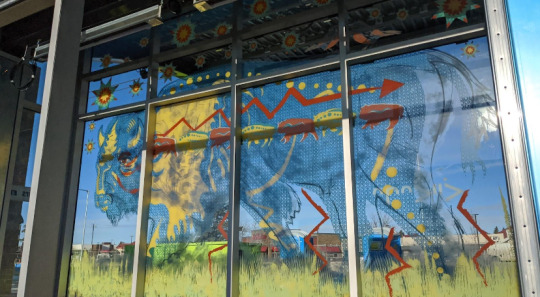
Tania Willard and Peter Morin, from the New BC Indian Art and Welfare Society Collective, set out to create a piece that shows the interrelationship between the past and the present while connecting the community to stories of the original caretakers of the land. For the Papaschase, this included areas that are now part of Mill Woods.
Engaging with the community and the Papaschase First Nation was important for the creation of the artwork at the Mill Woods Stop. Willard and Morin hosted a public event for members of the community and the Papaschase band to come together. In addition to sharing the concept for the stop art and gathering feedback, this event was also about community building. Guests shared songs and food prepared by local Indigenous-owned companies.
The event had a lasting impact on If the Drumming Stops. After the event, Willard and Morin invited a third artist with family roots in the Papaschase First Nation, Cheryl L’Hirondelle, to join the project. L’Hirondelle is a multimedia artist, performer and musician. At the event she shared a song called “Waniska”, or “Wake Up”. The Cree syllabics of this song are featured on the final art glass at the Mill Woods Stop.
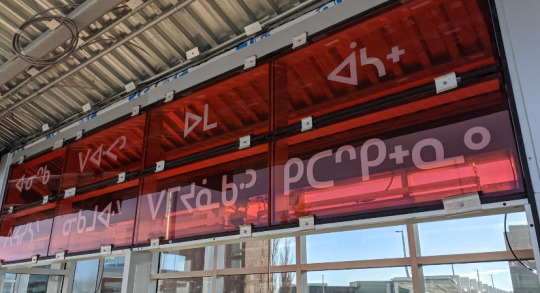
The Waniska song written in syllabics on the glass.
In English, the lyrics are:
Arise, daylight is upon us
the birds are already singing
our land is coming into beauty
The song was sung at the beginning of each day by a osākawēw (camp crier), as for the nēhiyawak (Cree people), the sky is a sacred being. Today, it is still sung at special events and ceremonies across this land. “The first rays of light each morning creates an awakening – that first conscious breath of awareness heralding the continuation for the possibility of life, and the work needed to be done for survival,” Edmund Bull.
To listen to the song, please click here.
Each element of the piece was carefully selected, inspired by the histories of Indigenous peoples who lived in the area. For example, the red coloured glass with the Waniska song syllabics on it is symbolic of the red colour of the woodpecker that Chief Pâhpâscês’ name comes from.
If the Drumming Stops visually connects the land and the people who lived in the area before it was called Mill Woods. The artists hoped to inspire Edmontonians to learn more about Indigenous peoples and their history in the area.
If the Drumming Stops is located at the Mill Woods Stop on 23 Avenue near Mill Woods Town Centre. Share your public art photos with us on social media using the hashtag #YEGPublicArt.
You can hear more from the artists about the artwork in this beautiful video by Conor McNally.
youtube
4 notes
·
View notes
Text
“I am YEG Arts” Series: Cindy Baker

Things I’ve Forgotten, performance at Southern Alberta Art Gallery 2018, photo by Jane Edmundson
Cindy Baker: a contemporary artist with an interdisciplinary research-intensive practice, working at the forefront of queer, gender, race, disability, fat and art discourses. From early on as a performance artist with what she describes as a “taboo body,” body politics and fat liberation have been integral to her artistic practice. Cindy’s next project not only pairs exceedingly well with some of her most-oft visited themes, it will also exercise her well-honed research chops. The Edmonton-based artist was recently recommended for the Coronation Recreation Centre public art project. Currently under construction, the Coronation Recreation Centre will serve as a community hub for central-north Edmonton that meets the leisure, health and wellness needs of residents of all ages. For the project, Cindy will create site-specific freestanding sculpture(s) for the facility’s large exterior entrance plaza.
This week for the blog, we talked with artist Cindy Baker about her initial plans for her new public art commission and got the scoop on her solo show currently on at dc3 Arts Projects.
Tell us about yourself and your connection to Edmonton.
I'm a queer, fat, disabled, contemporary, interdisciplinary and performance artist based here in Edmonton. I was born and raised in Leduc, and I moved to Edmonton in the 90s to go to school at the University of Alberta, where I got a Bachelor of Fine Arts. And I worked at the Fine Arts Building Gallery, the Works Art & Design Festival, Latitude 53 Gallery, Harcourt House Artist Run Centre, and Metro Cinema. So, I was deeply involved in the arts community before I decided it was time to move away. I was away for several years but Edmonton's home to my family, my support system, all my networks of people, my communities, and I just couldn't stay away.
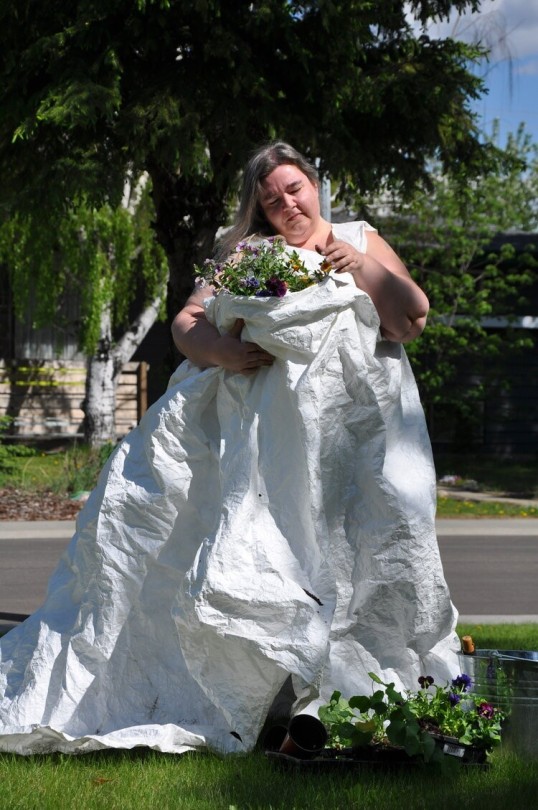
States of Resolution, performance at Edmonton private residence 2021, photo by Grace Lee
How did you get your start as an artist? Was it always plan A for you?
My parents were both teachers, so I always thought that I had to grow up to be a teacher too, but I always really wanted to be an artist. My mom's sister was an artist and I just idolized her and everything she did. And I was always drawing, painting, sewing, sculpting, crafting — doing crafts and art of all kinds. I never had a preferred medium, but I was just always making and working with my hands, so I always knew that no matter what I did for a living, I was always going to be an artist. I don't think I ever expected to make a living at art, but there is no way that I wasn't going to make art throughout my life.
Is there a narrative or discourse you find yourself returning to in your work?
I have a few major themes running through my work. To start with, the body, especially fat bodies and othered bodies are a major theme in my work. As a performance artist with a fat body and — what I call a taboo body — I knew it was always going to be read into the content of my work, so very early on in my career I made a point to become involved in body politics and fat liberation, to really inform the work and enrich the content. Productivity is another theme running through my work, questioning and resisting the moral imperatives of body, health and self-care that imply there are good bodies and bad bodies. That to strive towards being a good little productive cog in the wheel is a moral good. Therefore those who can't, or who fail to be this really strident definition of productive from our work lives to how we enact self-care, are inferior humans and less worthy of care or social support. So that's one of the major themes I think that has run through my work in the last decade.
And there are a lot of beds in my art and not on purpose, that's just kind of how it goes, beds and relaxation and toys and leisure activities like hot tubs and tricycles and swimming pools. I just keep coming back to rest and that idea of resisting productivity in the name of privileging and honouring the body's needs and care for one another being just as important as self-care.

Dream Come True, installation at Remai Modern 2020
These are subjects that have become very topical in recent years, have you noticed a difference in the reception to your work?
I think my work used to be a bit ahead of the curve and now I think it's very sort of right in what's being talked about in the world right now, especially to do with self-care and these neoliberal impulses towards productivity. And the world falling apart has us all questioning what we should be doing with our lives and our time. I think, especially since the pandemic started, we've all been rethinking what it is that we want to do with our time and our lives.
Tell us about the Coronation Recreation Centre public art commission that you've recently been awarded. What drew you to the project?
I'm really excited about it. I think the fact that the work will be connected to a leisure centre, which is also paradoxically basically a triathlon training facility, meshes so well with the themes I come back to again and again in my work. There's nothing leisurely about athletic training. It's work, and it should be valued as work, even if it's not the productive kind of capitalist labour that we've been taught to value. And on the flip side, I want to talk about leisure in a way that disconnects it from any need to perform, to perform work especially. I want to honor those who train and who engage in leisure activities as well, and those who can't or don't or won't, for any number of really valid reasons connected to bodies and time and desire and priorities and ability. Whether that's a body ability, financial ability, or what have you.
Is this your first foray into public art? Tell us about how it overlaps or differs from your overall art practice.
It's not exactly my first foray into public art, considering that my performance practice is often interventive and happens in public spaces, and is meant to be encountered by and engaged with by a general public. But it's definitely my first permanent public sculpture project. I don't consider myself a sculptor in the traditional sense, but I do make a lot of objects. And in my object making practice, no matter how hard I try, I can't seem to stop making big things that really have a presence. So, I do feel like this project is a natural extension of my practice and hopefully a new direction for my practice to grow into.
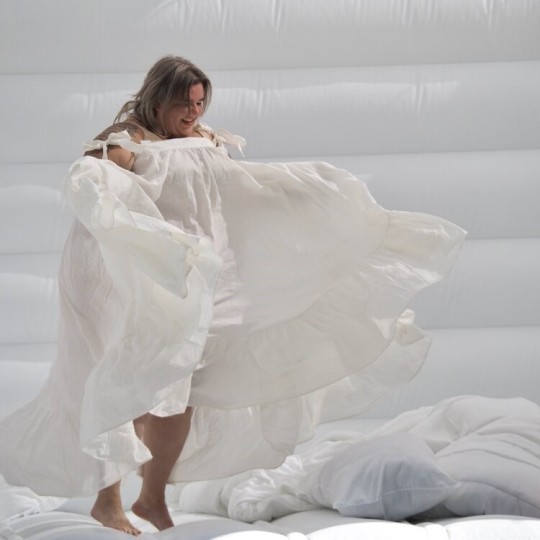
The Three Graces, performance with Mary-Anne McTrowe and Shanell Papp at MacEwan University 2021
Tell us about your interdisciplinary research-based approach. Will it be an important part of your creative process for this commission?
Yeah, I don't think any other project that I've done has put my research chops to the test as much as this one will. It'll be a really integral part of the creative process for this project. In research-creation practices in general, the research exists as much in the making as in engaging in traditional research methods. Which for me, and for this project specifically, means that all the making I've done in my practice to date exists as a body of research that's led me to this commission and will really inform and shape the work, and then in turn, the making of this work is its own research that will lead me to my next projects; be they new artworks, journal publications, conference presentations or incorporation into my university teachings. They're all one big whole in my work.
As you're working on this commission is it spurring on new ideas or potential new directions that you'll take from here in your practice?
As I develop the ideas for this project, I can see the threads coming out of other work that I've done. I don't think that that's unique, I think most artists have common threads that run through the work. But it's really interesting as I've grown and progressed in my career. It used to be that things felt very individual and from one project to the next, I didn't necessarily see those threads, but now I really see them throughout all the work.
What does community mean to you and where do you find it? What will your community engagement approach be for this public art project?
Community for me is family, whether that's blood family or chosen family, social networks and support systems. Community is my stomping grounds, workplaces, and favorite haunts. So, I find community where I find my people and that's for me, artists, fat community, queer community, thinkers and lovers of culture. For this project, more than talking to geographic community, I want to consult with people and organizations that are attached to communities that are traditionally underserved by public art projects and by recreation centres too; people with reduced access to financial resources, people who feel disconnected from that kind of facility, queer people and disabled people, people with mental health concerns. All those whose various demographics put them into the categories of those who don't fit those definitions of moral good, as defined by their abilities or their bodies or their productivity.
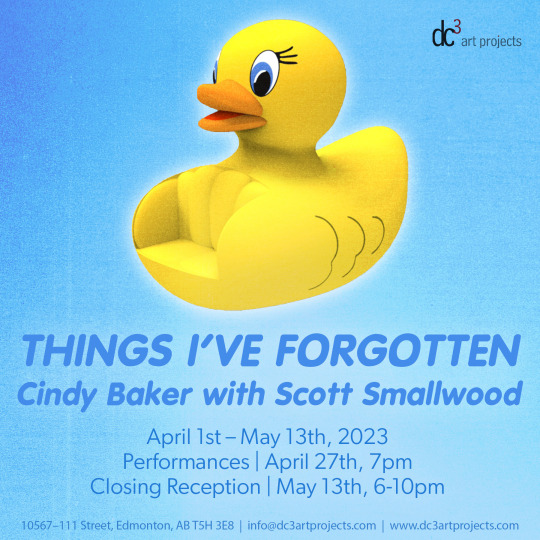
Tell us about your current solo exhibit at dc3 Art Projects.
The show is called Things I've Forgotten, and it's part of an ongoing work about my dreams. I spent about 10 years collecting a journal of my dreams. I would wake up every morning and write down my dream from the night before, and then never look back on it again. After 10 years I decided to start rereading my dreams and I was fascinated by the fact that they were so old and had long been forgotten because even though I wrote them down, I would forget about them shortly afterwards, like I think most of us do. I would read these dreams and they would be completely new to me and were completely foreign. So, I got to experience them for the first time, but then slowly the memory of the dream came back to me, and I could see all the images vividly and hear the sounds and smell the smells. It was as though the dreams had really happened and I was remembering them as a memory and at the same time I was kind of going through having heard stories about this trauma that happened when I was a kid but not remembering it, and I thought what if by reliving these dreams and pulling them to the surface what if I could bring this trauma to the surface as well? So, it sounds a bit like it was meant to be therapeutic, but I'm an artist and nothing is quite so literal, so I went about this project of working with my dreams to try and change myself as a person and see how I could be affected by this.
One of the works in the show is a collaboration by Scott Smallwood and me — he's a local audio artist — and together we recorded 20 different voice actors reciting my 10-year journal of dreams and created this really beautiful cloud of sound of all these overlapping voices, it's an 8-channel audio installation of all these overlapping voices. It's difficult to pick out any individual dream or any individual voice, but it does create this soundscape when you go in, that adds to the surrealness I think and beauty of it. It's very dreamlike.
What excites you most about the Edmonton arts scene right now?
I think Edmonton is exciting in general. I've only been back in a permanent way for a few years, but I think growth and change is what's most exciting to me. The arts scene here kind of feels like it's breathing and changing and growing and maybe that's exciting to me because I feel like I'm changing and growing too, which is exciting in its own way and makes me feel connected to Edmonton. I have to say that I love Edmonton cinema, theatre, festivals, music and dance, but my heart really belongs to visual and performance art. So, the galleries and the artists and the public art are what really grounds me to this city.
Want more YEG Arts Stories? We’ll be sharing them here and on social media using the hashtag #IamYegArts. Follow along! You can catch Cindy Baker’s exhibition Things I’ve forgotten at dc3 Art Projects. It’s on until May 13, and as part of the exhibit programming, there will be performances on April 27 at 7 pm and a closing reception on May 13 from 6 – 10 pm. Keep up with Cindy on Instagram, Facebook, or visit her website.

About Cindy Baker
Cindy Baker is a contemporary artist based in Western Canada whose work engages with queer, gender, race, disability, fat, and art discourses. Committed to ethical community engagement and critical social enquiry, Baker's interdisciplinary research-based practice draws upon 25 years working, volunteering, and organizing in the communities of which she is part. She moves fluidly between the arts, humanities, and social sciences, emphasizing the theoretical and conceptual over material concerns. Baker holds an MFA from the University of Lethbridge where she received a SSHRC grant for her research in performance in the absence of the artist's body; she has exhibited and performed across Canada and internationally. Helping found important community and advocacy organizations over the course of her career, Baker continues to maintain volunteer leadership roles across her communities.
2 notes
·
View notes
Text
“I Am YEG Arts” Series: Steve Pirot
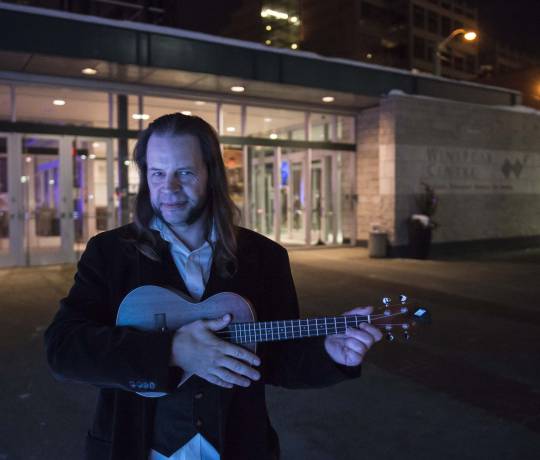
Photo by Marc Chalifoux
Grow where you’re planted. Steve Pirot certainly did—and has never stopped. That desire to express his growth and curiosity is something he champions not only for himself but others. iHuman Studios is where he accomplishes both, serving the needs of young and emerging artists, while strengthening a community to which he belongs. But that’s not the only place Pirot’s mark can be found. As an actor, director, and writer, he’s worked with most of Edmonton’s theatre companies… in the city that made him an artist… and the only place he’d ever call home.
Artist, absurdist, and rhyme-loving dreamer—this week’s “I Am YEG Arts” story belongs to Steve Pirot.
Tell us about your connection to Edmonton and why you’ve made it your home.
Edmonton is my beat because Edmonton made me. If I had been raised in a different city I would be made differently, but I was born here. And then—after that—I grew up here, and then—after that—I kept on growing up here, and then—after that—my rhythms had become so tuned to this place that any time I’ve been presented with the idea of relocation, I rediscover that I don’t want to make my home anywhere else. So here I am. What I didn’t know when I was 20, but can see clearly now, is that Edmonton in the 80s was disproportionately fertile ground for a young person curious about artistic experiences. That is kind of how being born here made me into an artist. It could have made me into something else, but I don’t think another city would have made me into an artist.
When you were first starting out, what was it about the arts that made you feel like you might belong there?
I don’t think I ever asked “where do I belong?” but rather “where can I serve?” (Maybe those were the same thing?).
In my early 20s, after a childhood obsessed with athletics, I kind of stumbled into theatre knowing almost nothing about it, and many people wondered what I was doing there. Mostly, “there” was the U of A Drama Department, and “when” was the late 80s when that department was producing lots of shows but was comparatively light on enrolment. So, there was always something for an undergrad to do, and I took advantage of that. I also took advantage of the non-profit arts organizations that needed volunteers, and I actually received more than I gave. For example: I was meeting professional artists, learning how organizations were structured, how to splice tape, how to coil cable, how to set up a box office, how to patch lights, how to print posters, how to distribute posters, how to get a keg, how to tap a keg, and who to talk to to get the real answers. I was peeking behind the curtain and building the beginning of my network. I didn’t know I was doing that, but that is what I was doing. Somewhere along that path came the sense that I belonged there because people stopped asking what I was doing there.
Tell us about someone who mentored you or helped set you on your path.
Just one? If I had to select one above all others it would be Tom Peacocke (leader, founder, major-general of the U of A’s BFA Acting program), but... that’s not unique only to my personal path. Tom trained a small army of theatre artists over the years, of which I was one of many beneficiaries. He was certainly the most important role model for me when it comes to the part of my path that is dedicated to serving the needs of young and emerging artists.
That said, I think I’d rather nominate one of the people who didn’t encourage me as my “someone who set me on my path.” I won’t name them. I won’t even say they were wrong, but having someone doubt my potential was even more motivating than confirming someone’s confidence. My path became more personalized and focused when I had something to prove.
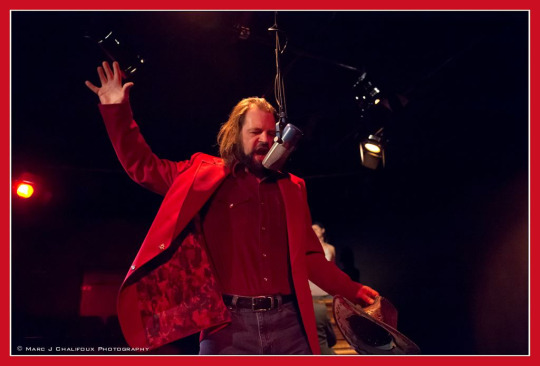
Apocalypse Prairie, photo by Marc Chalifoux
What themes are you drawn to as a storyteller?
To Dream is my favourite theme is to Dream, because first of all, rhyming: and then (b) the things that happen in our Dreams are not limited by the laws of (i) Time, (ii) Space, and (iii) Gravity... or Grammar for that matter, and fifthly because the Wild Rumpus that happens in my Dreams puts my Waking Life shenanigans to shame, and lastly because Dreams are something I don’t need to have to explain to someone because Dreams are a Universal Machine and first of all Dreams are Dreams, and Associative Logic is my favourite kind of logic and have you ever heard of a Tangent before or even a RUN ON SENTENCE full of irrational Nonsense because as an Absurdist I just have to say that have you ever noticed that when we gather people into a theatre to be an audience how often we ask them to sit still and sit quietly in comfy chairs and then we turn out the lights and tell them stories kind of like we’re asking them to fall asleep together for a little while but for a little once upon a time watch a story, a Bedtime Story, together kind of like almost like sort of like a Dream a Collective Dream and like maybe that’s a working definition of what culture is, a Collective Dream, Maybe Culture Is Our Collective Dream? Dreams.
Tell us a little about your role with iHuman Youth Society and what makes it special to you and the city.
iHuman Studios is both an Edmonton-based multi-disciplinary studio system and the artist collective of 12-to-24-year-olds who inhabit those spaces. Our mission is to transform trauma-informed experiences into experiences of purpose, self-worth, identity, and belonging. The primary tool we use to accomplish that goal is the arts.
I’ve been associated indirectly with iHuman since 2001 and have been employed as Artistic Director since 2016. My primary roles are the day-to-day supervision of the studio system and to represent our artists’ interests when they have opportunities to express themselves in the broader community. Working at iHuman fulfills a personal need to believe I’m using my skills in service of something more important than myself. I think iHuman is something Edmontonians should value because it is evidence that as a city we are aware that the playing field is uneven, and that we care to do something about it.
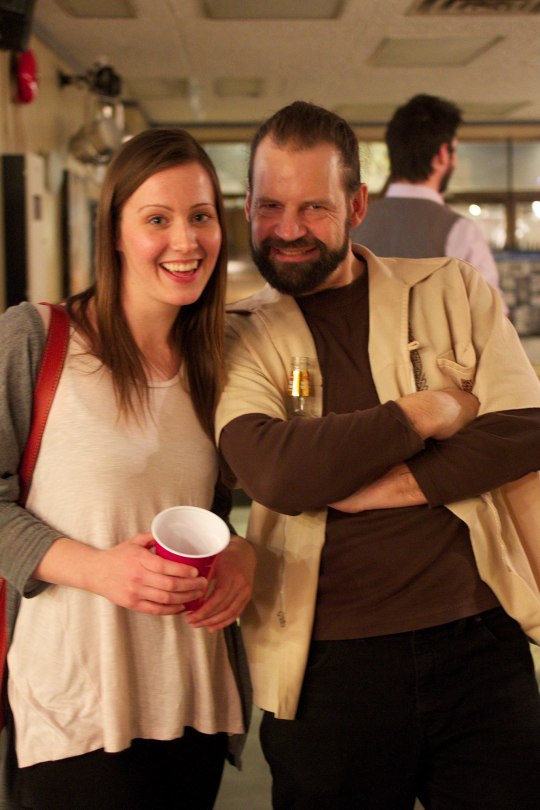
Alyson Dicey and Steve Pirot, photo by Majka Czprynski.
What does community mean to you, and where do you find it?
Community is a... system... or a network... a web... a lattice... a matrix? An ecosystem! Community is an ecosystem of... interlaced and interdependent individual entities that are... that are. They just are. They are interlaced and interdependent and... probably have common interests, but not necessarily common agreement on how to pursue those interests. And I don’t think that’s the type of answer the question was hoping for, but... it’s kind of like asking what oxygen means to me. I don’t know what it means to me, but I know that it’s all around me, andthat I take it for granted, and that if I don’t have it I’ll die. And that if I try to access it and it’s not there... then something has catastrophically gone wrong.
Tell us about a lesson you’ve had to learn more than once.
Nobody can read my mind.
Who’s someone inspiring you right now?
In Dylan Thomas’s A Child’s Christmas In Wales, the narrator speaks of “the distant speaking of the voices I sometimes hear a moment before sleep,” and that is what inspires me these days. Voices that are too far away from me to understand what they are saying, but clear enough that I can dig how they are saying it. I’m inspired more by the sounds of voices, rather than WHAT the voices have to say. I dig the music of the voices. I am inspired by the distant speaking of voices until those human voices wake me... and also by Kendrick Lamar.
When you think YEG arts, what are the first three things, people, or places that come to mind?
I’d usually say the Edmonton Arts Council as my #1, but given that this is an EAC platform, I’ll shake it up.
I’m putting The Fringe Festival as my #1 because it speaks to Edmonton as a festival city, to Edmonton’s place in the international arts scene, to how we are looked at as a leader in a North American context, to how arts activity can transform the identity of a neighbourhood, and it’s been a place of nascence for so many of the artists, companies, and audiences that inform the rest of the performing arts scene in Edmonton.
My #2 is the University of Alberta’s Faculty of Extension because of the groundwork dating back to the 1920s for a province-wide program of arts-and-culture education, the creation of the CKUA network, The Banff Centre For The Arts, Studio Theatre, all of the fine arts programs at the University of Alberta, and more. Remove that history of activity, and Edmonton doesn’t have the foundation upon which so much has been built in the past century.
And my #3 is The Artery. Yes, its legacy continues with The Aviary, but The Artery is more important in my mind because it got torn down. It is, therefore, part of history now and needs to be remembered as one of those dirty and dark, low-tech spaces that we will always need for an independent scene to thrive. As my #3, it stands for scores of spaces in Edmonton that had their moment: The Haven, The Living Room Play House, the Dance Factory, Studio E, Chess House, The Multi-Purpose Rumpus Room, Spazio Performativo, The Ortona Armoury, Wunderbar, and all those other spaces that I have forgotten about or have never heard of.
Describe your perfect day in Edmonton. How do you spend it?
A typical satisfying day in Edmonton involves: dropping off my skates for sharpening at Totem Outfitters, then buying a sandwich at Farrow, a coffee at Transcend, a book (or five) at Glass, a pint of ice cream at Kind, then back to Totem to pick up my skates for a late-night skate.
Want more YEG Arts Stories? We’ll be sharing them here all year and on social media using the hashtag #IamYegArts. Follow along! Click here to learn more about iHuman Youth Society.

Steve on top of the old Roxy Theatre, photo by Jill Connell.
About Steve Pirot
Steve Pirot (a.k.a., Unkl Stiv) is an Edmonton-based artist and administrator who has been the Artistic Director of iHuman Studios since 2016. Prior to that he was the Festival Director of Nextfest for 16 years, an Artistic Producer with Azimuth Theatre, an Artistic Associate of The Edgewise Ensemble, and a cast-member/writer of The 11:02 Show. As an actor, director, and writer he has worked with most of Edmonton’s theatre companies and has also presented work in Vancouver, Calgary, Winnipeg, Ottawa, and London, UK. He holds both a B.A. Drama and a B.F.A. Acting from the University of Alberta, has been nominated for a Sterling Award on six occasions, and regularly contributes to arts-based juries and forums. He’s written some plays, he’s acted in a few short films, and has a handful of credits for video game voice-overs. He has been participating in spoken-word open mics for over a decade and is currently working on a one-man show based on spoken-word forms, which will be presented at the 2023 Edmonton Fringe.
0 notes
Text
I Am YEG Arts Series: Titilope Sonuga
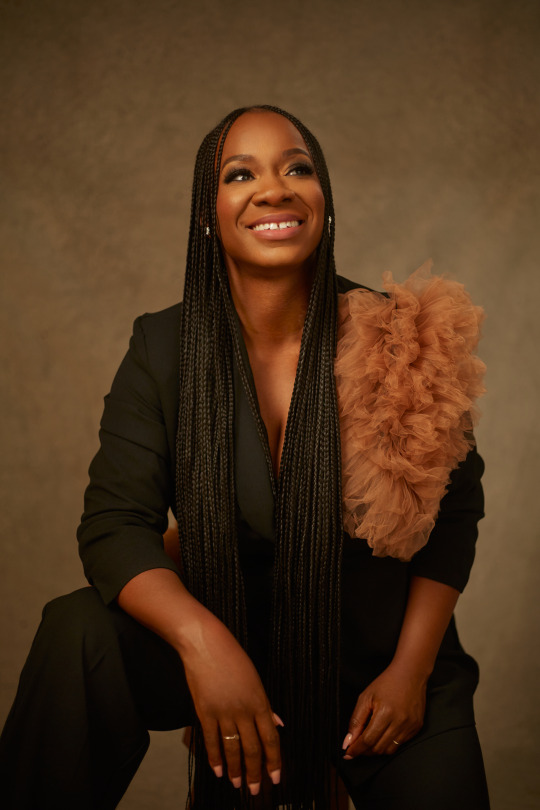
Photo by Jerrie Rotimi
A poet, performer, playwright, and occasional actor – wherever there’s a story to be told, that is where you will find Titilope Sonuga. Since 2021, Titilope has been serving as the Poet Laureate of the City of Edmonton, and her work, both written and spoken, has captured moments of tenderness and joy. As the time draws nearer to the end of her term as Poet Laureate, we caught up with Titilope to talk about her experiences, highlights, and where she sees herself going next. This week’s “I Am YEG Arts” story focuses on Titilope Sonuga.
Some people may not know, but you actually started out as an engineer. What inspired you to shift your path to pursue a living as an artist?
I'm not sure that I was inspired as much as I was pushed, kind of in a spiritual way, to go on and pursue this life in the arts. I had worked as an engineer for many years and followed that path because it seemed clear and easy, but I knew there was this kind of nagging in my spirit about this other life that I loved and hoped and wished that there was a way to build something out of it that was sustainable. And I think I got to a point, like a tipping point, where I had been doing poetry and arts on the side as a hobby while going to my job, and slowly the dream started to eclipse my real life. More and more I was taking off on weekends to go teach workshops. I was like Superman/Clark Kent where I was hiding my identity. I had to make a decision about what kind of life I wanted to live, and the one I chose was the one that felt most authentic and true. Wildly risky, but it felt like a risk worth taking.
As a storyteller, what narratives or inspiration do you find yourself returning to in your work?
I find myself in my storytelling always returning to the stories of women, and even in moments where I'm like, OK, I'm going to write a poem about [X], somehow I return, I guess metaphorically, to the place of my birth, which was from a woman. I think I'm deeply inspired by the many ways women can and do exist in the world, and the many lives that they choose, and the ways in which the world we live in hasn't necessarily been set up for us to flourish but somehow, we do. And the beauty of our flourishing is that we give other people, other things, other life forms permission to flourish as well. I think there's something really cyclical and regenerative about it. The lives of women – it's something that I find myself tipping back to in the stories that I want to tell and the stories that excite me.
How has your tenure as Poet laureate impacted your career trajectory and relationship with Edmonton and Edmonton's creative community?
I think my career has kind of evolved and continued to move in the ways that it likely already would have. But the role makes everything grander. It sets more eyes on your work. It introduces your work to more people who may not otherwise have known you. It invites you into spaces that you may not otherwise have been in. And so, I definitely have a bigger platform with which to do the things that I've always wanted to do and will continue to do.
My relationship with the city has continued to evolve in really beautiful ways. I arrived in the city as a teenager and so much of my formative years actually happened in Edmonton, and a lot of it as an artist. I think these new invitations into spaces have allowed me also to know the city brand new as well, and I’m trying to lean into what the people of the city love and desire and the many stories that exist here in Edmonton. I feel like the combination of my role as Poet Laureate, as well as a project that I just recently completed (Black on the Prairies where we're looking at Black life on the Prairies) those two experiences have really rooted me in this place as home. Edmonton is home, and has been for a long time, but it just feels more dug in now in a way that it hadn’t before.
As your term as Poet Laureate draws to a close, were there any unexpected highlights?
There were many highlights along the way. I think one in particular that I hadn't expected was that I've been invited to speak at many, many schools. I've done school workshops before as part of my work, but in this time, I've gone into junior high schools, I've gone into high schools, I’ve spoken to principals and administrators, I've spoken to teachers. For me, my journey as a writer and performer began in a junior high school in Edmonton, and so there's a really important role that that early introduction to literature served for me. And to be able to offer that back by the school visits where I’m meeting young people who are the age I was when I first started writing and hoping, fingers crossed behind my back, that whatever that interaction is with them will be a seed that they can remember later on when they say, oh, you know, I write plays, or I don't write but I journal and it's because a poet came into my school and said something one day.
I didn't expect that school visits were going to become such a big part of my work, but it's a part that I love quite deeply. I cherish the voices and opinions of young people and being in their spaces, posts 2020 and pandemic life has really, really enriched my life and work and I hope that it's been useful for them as well.

Photo by Fifographer
Is there anything you haven't yet accomplished that you'd like to do during your term?
Many, many things. I think the main thing that rings in my head is the Tenderness Edmonton project. I had thought, OK in the two years we're going to get so many tender stories and we're going to make this thing happen. I think I underestimated what point we were at in our collective healing. I think at the time it really did feel like we were around the bend; the pandemic was over, all that was going to be pouring out was these great stories of gratitude. But I think people needed more time, and as such I think the project needs more time. And stories did come in, but I think we are still at that point of figuring out and unpacking what the last few years have done to us. I had to offer myself and the people a ton of grace for the fact that yes, we have stories to tell and things to say, but maybe not yet. Maybe not immediately. Maybe we need more time for healing and recovery. Beyond my tenure, that's definitely a project that I want to continue to pursue.
What advice would you give to emerging artists?
Start with the truth in anything that you're creating. Let that compass be pointing toward the most radical, terrifying truth of your life, because ultimately, that's all there is.
Trust your voice, and that your voice in the way that you do your thing, however wacky and weird and strange, is actually where the sauce is; that's where the magic is. And there's always somebody on the other side of that who needs to hear you do your thing in the way that you do it. So much of what we do as artists is riddled by anxiety, insecurity, and fear. Like, will it be good this time. Will it be horrible? Is everyone going to know that I don't know anything at all? I'd say lean into that – that vulnerability and fear. Really magical things come out of that place.
What would you say is your greatest strength as a creative?
I think my greatest strength is my willingness to bear my heart, my willingness to be vulnerable. And it's taken me many, many years to get to the place where the stage isn't just a place of performance for me, but a place of real feeling and openness and vulnerability in which I know what I'm there to do, but I'm also open to the possibilities. That keeps me soft and that keeps the work as tender and honest as it can be. I think my greatest strength is that I'm not afraid to feel with people, and that invites them to come to the work with their vulnerabilities. I think many magical things have happened in that space. So yeah, my greatest strength is actually what makes me most soft.
Tell us a little bit about what you're currently working on and what you hope to explore next.
I've gotten two really great pieces of news in the last couple of weeks. The first was a large project grant from the Edmonton Arts Council to work on my next album, Sis, which is an exploration of Sisterhood and friendship and relocating “friendship” as a really beautiful place of transformation and strength as the ultimate love story. We view romantic love as the pinnacle of all loves, but I think about friendships that predate my marriage, I think about friendships that I knew even before I was an artist. That's the love that sustains. That's the love that has transformed my life. And so, this album is a love story to all the women who have braced me throughout my life.
And then I received another project grant from the Canada Council for the Arts to work on another iteration of Open, which is my live poetry show that incorporates music. This version will allow me to transcribe this work to classical sheet music and work with an orchestra to re-explore poems with music and what that does in a performance setting. I'm hoping, if I follow my timelines, it will be my farewell show for my role where people can come out and experience this work with a 30-piece orchestra that I'm working with out of Calgary, as well as Melafrique. It'll be a really fantastic exploration of poetry and music and all the ways that words and music are like a perfect marriage.
What I'm currently working on and what I'm hoping to explore next are intertwined, but just more of being out in the world again. I've had in the last few weeks more live performances than I have had in the last three years. I really love the stage and being in call and response with other people, and so more of that as we go forward is what I'm hopeful for.

Photo by Abumere Photography
About Titilope Sonuga
Titilope Sonuga is a poet, playwright and performer whose work grasps moments of tenderness and persistent joy at the intersection of blackness and womanhood. She is a leading voice in local and international poetry communities who has travelled extensively as an artist and facilitated adult and youth poetry workshops worldwide. She has served on various artistic and community boards in Edmonton and is the founder of the Breath In Poetry Collective, a mentorship and performance platform for emerging poets. Sonuga is the author of three collections of poetry, Down to Earth (Self Published, 2011), Abscess (Geko Publishing, 2014), and This Is How We Disappear (Write Bloody North, 2019) and has composed and released two spoken word albums; Mother Tongue (2011) and Swim (2019). She has written three plays, The Six; an intergenerational exploration of womanhood, Naked; a one-woman play and Ada The Country, a musical. Sonuga has scripted global advertising campaigns for numerous organizations, including The Bill and Melinda Gates Foundation, Google, Intel Corporation, The World Health Organization, White Ribbon Alliance and The MacArthur Foundation. Her writing has been translated into Italian, German and Slovak.
Titilope Sonuga will conclude her two-year term as Edmonton’s Poet Laureate on June 30, 2023. Keep informed about Titilope’s work and events by following her on Twitter, Facebook, and Instagram, and visiting her website.
0 notes
Text
“I Am YEG Arts” Series: Frances Whitford

It’s been said that grandparents are the voices of the past and the door to the future. For Frances Whitford, there are few truer sentiments. It’s why she describes her business, Beadwork & Bannock, as a creation of love and legacy to her grandparents and Métis culture. Lucky for us, that gratitude and knowledge are both gifts she’s eager to share with everyone. From passing down traditions to her children to championing the Indigenous Artists Market Collective (I.A.M), Frances looks forward to continuing to promote and support the perseverance of Indigenous art and culture in our city. Artist, advocate, granddaughter, and teacher—this week’s “I Am YEG Arts” story belongs to Frances Whitford.
Tell us about your connection to Edmonton and why you’ve made it your home.
I have a lot of family here. I’m from northeastern Alberta, just outside of Fort McMurray, so Edmonton was the closest major city and our go-to for everything—so we’ve always been connected to it. Even as a kid, we’d go to Lac Ste. Anne every summer, and then to K-Days because my grandmother had sisters and family here. From there we’d go around to Lac La Biche to the powwow before heading back home. So ever since I was a small child, I’ve spent a few weeks of every single summer here.
As an adult, what really drew me to Edmonton were the opportunities for my three children to grow. Being in a small community is great—the support you have is good, everyone knows your name, and your history, and all of those types of things—but sometimes that can put a real damper on personal growth when it comes to just wanting to spread your wings and be yourself. So all the genres of opportunities presented to them here were very alluring to all of us.
I also found the Indigenous Artists Market Collective (I.A.M) here, and that was amazing. I always say that when I found them, I found my tribe. As Lorrie Lawrence always says, it’s like a melting pot of Indigenous artists.
Tell us a bit about Beadwork & Bannock and how it came to be.
I grew up raised largely by my grandparents. They were very old-school, very Métis lifestyle, so I spent a lot of my youth on our family trapline, which my brother still runs with my cousin Jason. Despite being so immersed in my culture throughout my life, I didn’t realize then how blessed I was—not until 2011 when my grandmother passed away. She had developed Alzheimer’s around 2006, so it really felt like we lost her a lot sooner, but during that time was when I really began to realize that, wow, once she goes, all of this is gone.
My grandmother was an artisan herself and used what she earned to help supplement the family income. I loved watching her work, and a lot of time I’d get to play around sorting beads… but watching her create all these amazing things and seeing every part of the process—from trap to this beautiful pair of moccasins—was pretty cool. So when she passed away, I made my decision to allow myself to dream about making a living preserving my culture and being able to share it with others and teach my kids. Beadwork & Bannock was the answer. And there’s just so much good that has come from it. It is literally a legacy of love for my culture, my grandparents, and everything they’ve instilled in me. There were quite a few years of dreaming it up in my mind and wanting to be where I am now, but just knowing that this knowledge is for me to pass on to as many people as I can reach makes me very happy.

What inspires your design choices and the stories that your beading and clothing tell?
Again, it goes right back to my grandparents and realizing how much culture they preserved in me that I didn’t realize I carried until I was older. A lot of my beadwork designs are inspired by the work of my grandmother and from learning and exploring our Métis culture. As I did my genealogy, I realized just how far-reaching my Métis ancestry is when it comes to Canada and the United States. Because we were the landless people, we travelled so often that there are bits and pieces of my grandfathers’ and great grandfathers’ and great-great grandfathers’ families from Montana all the way through Saskatchewan and Manitoba. It’s pretty amazing to see that. So often I’ll look at all this beadwork from all over these places and feel such a connection to it. And at first, I don’t understand why until I realize it’s that ancestry that draws me in.
What’s one piece of advice you wish you’d had when starting out? And what’s something you knew instinctively that’s still serving you?
The advice I wish I’d had starting out is don’t limit yourself—don’t limit yourself to what you can and cannot do. When I first started, I felt very much that I was in this box and had to stick to mitts and moccasins and the traditional things my grandmother made. But as I’m evolving as an artist, I like to bring in contemporary elements and incorporate new-age thinking with the old—like repurposing fur coats. It’s conservation in itself. And a lot of what we do as trappers is conservation work. Some people have the misconception that we’re out there hauling out these furs and mass-producing and selling them. But, no. We’re actually doing a lot of environmental monitoring. So, for example, if there’s a species that’s low, we’re not going to harvest it. We’re going to refrain. Or if we’ve noticed a species is diseased, we’re submitting that all to the government to be tested to make sure that it’s not something invasive to these species.
The something I just knew from the get-go would probably have to be the importance of transferring knowledge. That was just the biggest driver for me after losing my grandmother and realizing that a lot of her knowledge was gone. Though I only have bits and pieces of it, I’m learning and growing on it every day, remembering more as I carry on. I also realized how important it is for us through truth and reconciliation to share that knowledge back and to give it to our future generations so that they can continue to grow on it and ground themselves with it—because that’s what it did for me.
I strongly believe that the knowledge and traditional practices I was given were meant for me to transfer, not to hold. Letting everyone know there is space for all of us to share and learn these things is something I’m very happy to do.
Tell us about someone who mentored you or helped set you on your path.
That would be my brother. I can really say that my brother has always been one of my biggest supporters and champions. When my grandmother passed away, the two of us sat down and had a conversation about my kids really needing to go to the trapline with him. They were all very small then, but I knew they needed to go with him alone because at that age Mom is everything—Mom, do this. Mom, do that. The trapline is a very wonderful and magical place, but it can also be very dangerous, so I knew they needed to build their relationship with him and the respect he required for them to safely enjoy trapline living—and to learn to grow their wings and be independent. So when my son was around 6 and my other daughter was 10 or 11, they went for their first weekend on the trapline with my brother. And that all started it. That’s when we both realized that if we didn’t transfer that knowledge, it’d be gone. From there, we started to talk about all the things that Grandma would make and decided to give it a try. The rest is history!
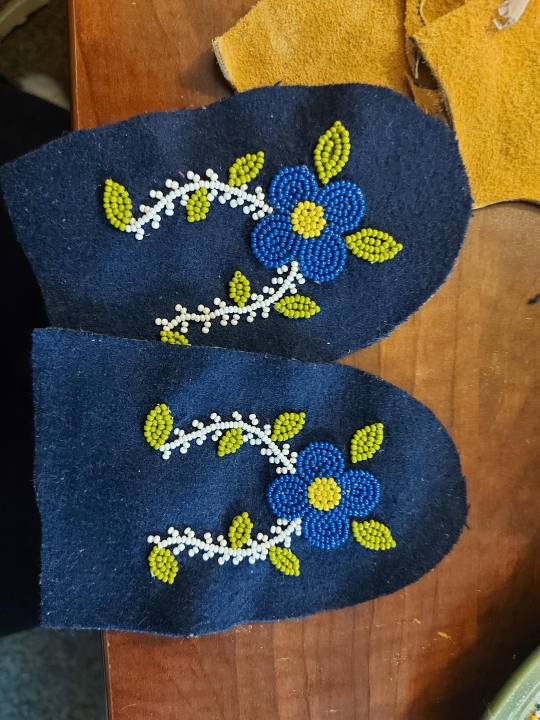

Who’s someone inspiring you right now?
Right now, I would probably say the artists with I.A.M. They have so many stories and inspire me so much with their resilience. There’s such an incredible amount of knowledge coming off each of these artists that stems from their families and their histories. And it’s just so inspiring to me to see our art coming back and being appreciated for what it is. The dedication each and every one of them shows to their craft is incredible. We even have one artist, Agnus Jones, who I believe is 89 years old. She does a lot of the similar work that I do, and the last time I saw her at the market I told her that, in my eyes, I am just an apprentice, she is a master, and that—one day—I hope to be as good as her.
Last year, you and your son designed a T-shirt for Orange Shirt Day. What was that experience like for you?
Normally, T-shirts are right out of my element, but I just felt called to tell this story (of our family’s journey of truth and reconciliation)—and to include my children. Part of our coming to knowledge of our past with residential school really shed light on understanding that we have our own story to tell. Knowing that the world is seeing the truth now, we needed to stand in our own truth. So I just really wanted my children to understand their history, as much as I can teach it, and as much as I can learn it myself to pass it on to them so they can understand why we are the way we are these days and which direction we need to move in. I needed a positive outlet to empower them to know that healing is possible, and necessary, and important for them to think about. That’s the real legacy I’d like to leave—that we need to move forward in a positive light, and that sometimes extracting a positive from a negative situation is the best way to grow and heal. That’s what I hope my T-shirts will do.
Tell us a bit about what you’re currently working on or hoping to explore next.
What I’m working on right now is focusing more on my beadwork detail. I just want to grow a little bit more, and explore a little bit more, and venture out into making new things, like satchel-style purses.
I’ve been exploring new mediums and playing around with caribou tufting, too. And it’s like, as soon as I understand my connection to these animals and these things, all of a sudden the creative comes in and I want to work with parts of them!
The kids and I are also working on more Every Child Matters T-shirts and collaborating on some other designs.
What do you want people to understand about the importance of buying Indigenous products from Indigenous artists?
It truly is a preservation of culture and of legacy. Our Indigenous art tells the story of our history, of our connectedness to other cultures and other places, and reminds us of the unity that we need to continue to share. I think it’s good to walk in your individual light and be proud of who you are and where you come from, but it’s also good to be proud of other cultures too—to raise them up and know that you stand in unity with them. So that’s what I’d like people to know: that when they purchase Indigenous art, they’re not only supporting an artist, they’re actually preserving a culture. And that’s an amazing thing.
Describe your perfect day in Edmonton. How do you spend it?
My perfect day in Edmonton would probably be spent exploring one of the many festivals or attractions that you literally find every weekend and everywhere you turn. Spending it with my kids, of course, because I love that.
You visit Edmonton 20 years from now. What do you hope has changed? What do you hope has stayed the same?
Well, I do hope that all the festivals and everything have stayed, but what I really hope to see is more reflection of the Indigenous presence that is here in the architecture and everywhere you turn. It’s starting to look like that now, but I’d really like it to be strongly visible. For example, the history behind the river lot that was here really needs to come to the surface—and in a good way. Because even though it’s a dark history, it’s a very positive place, and I love being there.
Want more YEG Arts Stories? We’ll be sharing them here all year and on social media using the hashtag #IamYegArts. Follow along! Click here to learn more about Frances Whitford, Beadwork & Bannock, and more.

About Frances Whitford
Frances Whitford is originally from Anzac, Alberta, but now calls Edmonton home. She was raised by her grandparents and grew up surrounded by Métis culture and craft, spending much time on the family trapline. Frances learned most of her craft from her grandmother, a Métis artisan, who made various pieces for the family and to sell in an effort to supplement the family’s income. Her grandfather was a trapper who would supply the furs and hides needed for her grandmother’s craft. Today, Frances’s brother has stepped into the role of trapper and supplies a large amount of the hides and furs that allow Frances to continue to learn and hone her skills.
Frances’s pieces, such as moccasins, mukluks, gauntlet mitts, and other Métis-oriented items, are made mainly of traditional and commercial-tanned moose hides, as well as beaver, fox, lynx, rabbit, and various other types of furs. Some of her Beadwork & Bannock pieces also include her beadwork.
As Treasurer of the Indigenous Artists Market Collective (I.A.M), Frances looks forward to continuing to promote, support, and participate in the advocacy and perseverance of Indigenous art and culture that she sees thriving in this city.
1 note
·
View note
Text
“I am YEG Arts” Series: Jen Mesch
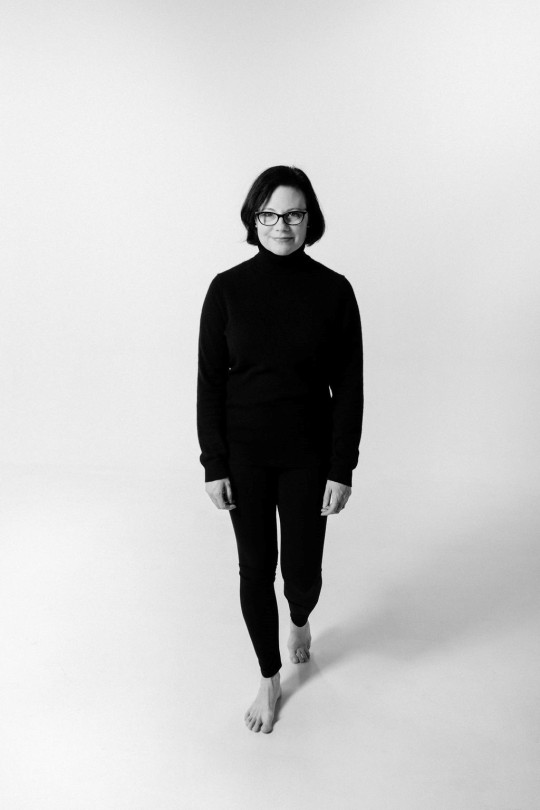
Photo by Aspen Zettel, 2021.
Contemporary dancer and choreographer Jen Mesch’s creativity is seemingly boundless. She doesn’t shy away from new adventures and challenges, whether it’s a fascinating new collaboration with an experimental musician or mastering a new artform (in recent years she’s added film to her repertoire). She’s a multi-disciplinary artist in the broadest sense and embraces cross-training not only in dance, but in other schools of thought such as philosophy and science, and by staying in tune with her community.
This week on the YEG Arts blog, we catch up with the multi-talented artist, Jen Mesch.
Tell us about your connection to Edmonton and what keeps you living and working here.
I moved to Edmonton a little over 13 years ago from New Jersey. My husband who's a composer got a job working at the University of Alberta and I started working here as a healthcare worker. I guess my sort of “Edmonton origin story” in dance is that I looked up what kinds of things were happening and found Mile Zero Dance. I saw this photograph of Gerry Morita [Mile Zero Dance’s Artistic Director] in a fake fur coat in front of a barn with these wild sunglasses, drinking a cup of tea, doing a little bit of a dance pose – and I knew I was going to be fine in Edmonton! Mile Zero has really been a great place for me, I have performed there as an independent choreographer, and since the beginning, I really was welcomed with open arms into that contemporary community and just this year I decided to be on the Board. It has been kind of a home base for me as an independent choreographer.
As a multi-disciplinary artist, is there a common thread you bring to all of your storytelling? Are there themes you find yourself revisiting time and time again?
I think people look at dance and see a story – that's a normal thing for humans to do – to look for meaning or a story, but [as dancers] we're not actually trained in storytelling. I think that's a specific skill, it's literary. People often don't ask the same thing of music, and dance is sort of uniquely situated in that we're connected very strongly to music. Obviously, we also have a strong connection with theatre and performance art. But we're also completely different from all of them. I definitely try to steer away from storytelling and I think that's hard in a big theatre town (it's a big literary and music town too.) I think it's hard for people outside of the dance community to find their way into non-narrative work. But the common themes for me are that I tend to work as a soloist as an independent choreographer. I'm pretty reclusive in my daily life so I do a lot of solo work and a lot of the themes involve solitude, organic sorts of landscapes and in the case of my current work Go Where Light Is, I guess outer space and the universe are included in an organic landscape.
What's one of the biggest professional risks you've taken, and how did it influence where you are today?
The biggest professional risk I ever took was deciding to become a dancer at age 22 because I didn't study dance as a child. [As a young adult] I did start taking dance classes, and then I went on to major in engineering. There was a talent show at my engineering university and I entered one of my little dance pieces and won first place. The $50 prize meant I could buy my chemical engineering textbook; I was so happy and relieved. Eventually, I dropped out of engineering and told my parents I wanted to be a dancer, which was, I think pretty wild of me to do. I mean, I'd had just twice-a-week classes at my community college in modern dance. I had come back from dropping out of engineering school and I asked my dance teacher what I needed to do. She said, Take as much ballet as you possibly can, and take jazz and modern – take everything. So I did. I took all the money from my minimum wage job and took every dance class that I could take. I was in classes five or six days a week. I don't see myself as a super high-level dancer at this point in my life, but I can't believe how much I've done and have been able to do. So, I guess that my advice to other people is to try. You don't know unless you do and put everything into it. It could have gone nowhere for me. I could have changed my mind, but here I am.
What's one piece of advice you wish that you had received when you were starting out in dance?
I was an adult when I started studying dance so it's a bit different than when you started out as a kid. I started with some already firm ideas of who I was and what I wanted dance to be for myself, but I think one piece of advice I wish I had (which I do anyway) is the notion of cross-training. Both physically and in terms of genres or disciplines, I think it's really important that people learn about other artforms, learn about other schools of thinking, about philosophy, and the sciences. All of those things make us more rounded human beings and should inform our practices as artists.
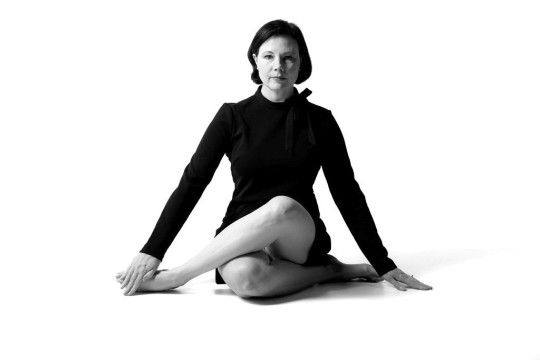
Photo by Aspen Zettel, 2021.
Tell us a little bit about the unique characteristics and challenges of dance in contrast with other art disciplines. What do you wish people better understood about dance?
Well, I think it's changing a little bit, but there are some biases against dance (at least in North America) that dance is sort of inherently female and that it's inherently recreational. So, I think it gets discounted. People understand that you can be a recreational photographer; you can be a professional photographer. I think people do understand that there are ballet dancers that are very highly trained, but it seems so unattainable for most people. That is a big wall that I think we're all trying to figure out how to break down a little bit – these hierarchies in dance.
Another disadvantage is that it costs a lot of money to put it on; it's very labor intensive; and it's a very personnel intensive art form. Dance is seen as being mostly for girls and women, even at young ages. It's very hard to find role models for boys who want to dance and yet it's often men who then become the major choreographers and the major directors of dance companies. Women are trying to find their voice at a time when we're also stepping aside to make more room for more kinds of people and more kinds of dancers. I think that's a challenge for everyone in the arts – to make more room.
Another significant problem for Edmonton and anywhere really, is that compared to other art forms, there are fewer dance programs at the post-secondary level. Edmonton currently has nothing like that as opposed to very fully realized theatre and music departments. It’s something that the dance community is trying to address. At the same time as we're trying to increase scholarships and increase awareness of dance, we're also trying to increase awareness of each other's dance forms and dance communities.
Tell us about your most recent dance project, Go Where Light Is.
Go Where Light Is has been a really exciting and challenging project. Because I normally work as a soloist, the larger-scale things that I've done have been with improv structures that have been quite loose. Like I construct a general timbre of the piece and they're usually people spread out over large areas so that people sort of come upon little things happening in different places in an area. With this one, I don't want to say this is my pandemic piece, but I did really miss dancing with everybody. I just had it in my heart, I wanted to do something really big with lots of people in it. I also had these really strong eerie feelings of the universe really not just being something out there in outer space or something that requires technology to perceive. That it's really just around us all of the time. And all these distances of course are relative. And even during the day, it's not something that happens at night, where we can see stars. The stars are just always there. And I just started thinking about how strange the world is as we've created these structures and systems around us. I started thinking more and more about the uniqueness of the human animal and the context of the universe without all of these constructs around us. So that's kind of where I started. There are a lot of themes that come through in the piece, the music steers a lot of it. The piece was written by my husband Scott Smallwood and his collaborative partner Stephan Moore.
Tell us more about your filmmaking.
In 2016-17, I was the artist in residence at Harcourt House. The residency is meant to support the work of an artist as they advance or emerge into a new area of their work. I was in my late 40s by then and I was dealing with lots of injuries and thinking a lot about what I wanted to be doing and about the online presence of dance. And I started thinking I would like to learn how to do dance for film and during the residency. I started taking film classes at the University of Alberta and FAVA. I made some little films in those classes, and they became part of the exhibition at the end of my residency, and then I found out that you could submit online to film festivals, so I got into a bunch of film festivals which was weird and fun. I felt a little bit upset because I'd been making films for, like, not even a year and I was getting awards for filmmaking. You could just never do that with dance! It’s said it takes ten years to make a dancer. I told my teacher that and he said, “Well it's different for you because you're already an artist.” I suppose that's kind of true, I already have strong compositional ideas and content ideas. It is a very different medium. It turns out I really love editing and it goes back to this whole thing of kind of being a person of solitude.
Can you tell us about a hidden gem in Edmonton’s dance scene that you think more people should know about?
Mile Zero Dance is opening up a new space in the next little while in the Ritchie neighborhood and I'm really excited to see how that's going to affect everything. Both in terms of having a more solid and secure location for themselves and what it's going to bring to dance. That's probably the thing I'm most excited about.
Want more YEG Arts Stories? We’ll be sharing them here and on social media using the hashtag #IamYegArts. Follow along! Click here to learn more about Jen Mesch.
Listen to Jen Mesch tell her story on CBC Radio’s Radio Active show! Aired March 23, 2023.

Photo by Aspen Zettel, 2021.
About Jen Mesch
To say that dancer/choreographer Jen Mesch inhabits any performance she gives is an understatement. Described as enigmatic, unusually perceptive and artistically fearless, Mesch’s wide variety of interests often lead her to unique collaborations in unexpected places.
Mesch has created over 200 works for dance performances, film, and experimental theatre in the US and Canada. She has performed with Cindy Baker, Dawn Cargiulo Berman (Momix), Penny Hutchinson (Mark Morris Dance Group), Jack Magai (Troy Chainsaw Ensemble), Linda Mannheim (Martha Graham Dance Company), Jennifer Monson (Birdbrain Dance), Gerry Morita (Mile Zero Dance), Susan Tenney (Jane Erdman Dance) and Kimberly Young (a canary torsi). For over a decade, Mesch has worked primarily with experimental musicians and has performed with Roger Admiral, Nico Arnáez, Allison Balcetis, Stephan Moore, Will Northlich-Redmond, Scott Smallwood, and Nate Wooley. She was the 2016-2017 Artist in Residence at Harcourt House which culminated in a two month dance, film, and visual art installation in fall 2017. Her film Hard White Spring received the award for Outstanding Experimental Film or Video at FAVA Fest and it was a semi-finalist in Cinema d’iDEA festival in Rome. Her first film, Soft Red Winter was screened at the Venice Short Film Festival. Mesch also teaches dance improvisation and technique, and her writings on dance have appeared in The Dance Current (Canada) and on her own Dance Conspiracy blog.
1 note
·
View note
Text
Reflections on the Horizons Writers Circle by Naomi McIlwraith
Fourteen Alberta writers recently concluded their participation in the Writers’ Guild of Albera’s Horizons Writers Circle, its mentorship program for writers within the Black, Indigenous, and People of Colour (BIPOC) community, ESL, and underrepresented writers living in Edmonton. The program ran from October 2022 to March 2023, under the coordination of publisher and writer Luciana Erregue-Sacchi. Writers from diverse backgrounds in the early stages of their careers received mentorship from experienced writers in a series of workshops, panels and one-on-one activities. The program introduces new writers to the wider Edmonton community, helping them make new contacts in the industry, and thrive in their writing careers. We asked two of the participants, mentor Naomi McIlwraith and mentee K’alii Luuyaltkw to reflect on the experience for the EAC blog. (You can read mentee K’alii Luuyaltkw’s guest blog article here).
Inward Journeys and Saskatoon Pie by Naomi McIlwraith
Writing is a journey from an urge to an idea to a crafted composition. It’s this process that both intrigues and inspires me when I think of how the human brain goes from the tiniest little seed of a thought to a finished piece that has been nurtured with water and sun and love into a polished whole that is now a Saskatoon bush, bows bent with juicy fruit, in the full flush of the last two weeks of July. This to me is what mentoring looks like too, especially mentoring newer Indigenous writers with their own writing. When I went a few years ago to a strange bar somewhere in Edmonton for the 30th reunion of my high school graduation, I was struck by the bizarreness of it all. As I ruminated over the fact that we were all 48 winters old, a really rich guy from my high school days came over to commiserate with me that he’d had to settle for being a plain old doctor when he couldn’t invest all that time into being a specialist. Now it’s been 42 winters since I graduated high school, and I’m still fighting the same old battle of how to make a living as a writer, as my really rich doctor friend contemplates retirement. I am, however, the luckiest woman in the world with all the beautiful opportunities that have come to me because I chose writing, the most recent and most important a Mentorship opportunity with the Writers’ Guild of Alberta’s Horizons Writers’ Circle for BIPOC writers. A thinker, a teacher, a writer, a poet, – all these roles I love doing as I mentor new writers. I love how the Mentor/Mentee relationship is just another glorious example that the real world is better and infinitely more interesting than all being the same age at the same time. My need for Saskatoon bushes and rivers and mosquitoes and bright yellow warblers with skinny little red streaks on their feathery breasts means that I don’t fit well into a classroom with four walls. But I get to be a teacher in other creative ways. Writing has helped me find my voice, and I am vibrating with glee that I get to mentor new writers as they find their own voices. A speechless wisp of a girl 42 years ago, I’m not quite so wispy anymore and I’m not quite so speechless, and this is all because I have been blessed with the best of Mentors who have helped me not only find my voice but find myself. Voice is identity too. Part of my voice is Indigenous and part of my voice is Scottish, English, Norwegian, French, ….. And I now take quite seriously my responsibility to share all that I’ve learned and all that I’ve gained from my Mentors as I help my Indigenous Mentees find their voices and discover who they are. As a Métis woman, I am a peacemaker negotiating all of my identities, and to my role as a Mentor I bring my skills in negotiating and talking, listening and laughing and cajoling my Mentees into planting for themselves all the seeds that will ripen as their composition germinates and is refined into a delightfully finer form than the first draft. This is absolutely essential that the Mentor reject expecting perfection either from herself or from her Mentee. Perfection means paralysis: as a Mentor, therefore, I encourage my Mentees to get their words down onto paper in whatever form they land. As a Mentor, I am duty bound to show my Mentees the way to get their ideas down onto the first draft and then to point them in the direction down the trail through the second, third, fourth, and fifth drafts until they have nurtured their thoughts into the exquisite form that is now a Saskatoon bush reaching high into the sky. Writing is by nature an interior journey: thoughtful people we writers are. nêhiyaw philosopher Willie Ermine’s comment about the inner journey makes a great deal of sense to me:
The relentless subjugation of Aboriginal people and the discounting of their ideas have hurt those aboard the Aboriginal voyage of discovery into the inner space. The tribal crews, along with their knowledge and secrets, came precariously close to aborting their inward missions. Meanwhile, the Western world-view and the concomitant exploration of the outer space continued unabated for the next five centuries. Acquired knowledge and information were disseminated as if Western voyages and discoveries were the only valid sources to knowing. The alternative expeditions and discoveries in subjective inner space by Aboriginal people wait to be told (Ermine “Aboriginal Epistemology” 1995).
Subjective inner space indeed. This is what being a Mentor in an Indigenous artist context means to me, and I aim to help my Mentees find their voices and themselves in their own subjective inner spaces. My Indigenous Mentees’ stories are waiting to be told!
Nearly twenty years ago, I served as the Conference Scribe for an Indigenous Feminism Conference at the University of Alberta, and Dolores van der Wey, an Indigenous presenter, said something that became a gift and has stayed with me since. She spoke about “pause time,” which is the time a listener takes to absorb and process what she has heard from someone speaking to her. Rather than interrupt her duty to listen deeply, the listener maintains her commitment to attend to the speaker. The listener refrains from checking out of the conversation to think of how she will respond to what is being said to her, she resists the urge to impose her own thoughts on what she hears, and she accepts the invitation of the speaker to journey inward.
The listener listens, truly listens. What a gift!
This pause time is rich with potential, and this is another powerful motivator for me. I do fiercely believe that listening deeply is an Indigenous cultural practice that must continuously resist the noisy forces of a colonial world that makes it difficult to hear and to listen. I am a peacemaker, and I want to hear my Mentees thoughts fully and completely, so that I may coach them forward in the best way possible. This pause time is a gift that the listener gives to her interlocutor. It is a gift to be heard above the cacophony, and the Horizons Writers’ Circle offers Mentors and Mentees an important opportunity to hear each other deeply and meaningfully as they venture inwardly toward those tiniest little kernels of thought, thoughts as nascent as a cluster of seeds and help them grow into a beautiful juicy Saskatoon pie of a composition that we simply cannot resist!
Thank you to Ellen Kartz for being such a champion of writers and for inviting me to apply to be a Mentor, Luciana Erregue-Sacchi, Program Coordinator of the Horizons’ Writers Circle, Giorgia Severini, Executive Director of the Writers’ Guild of Alberta, and to Rona Altrows, the Edmonton Community Foundation, and the Edmonton Arts Council for supporting this important program that is so vital to the health of our community!
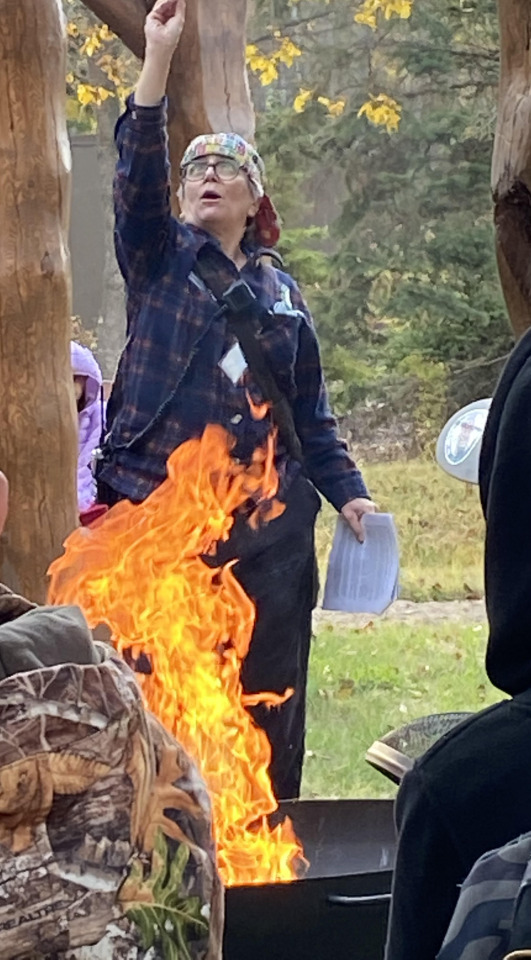
A writer, a teacher, a canoe paddler, a trail walker, and a deep street talker extraordinaire, Naomi McIlwraith is a Métis poet who reads and writes and listens and talks to figure things out. Moreover, Naomi writes to honour her ancestors both Indigenous and European, her Mom and Dad and the rest of her family. She also writes and talks to make peace in a dangerous world. You will find “Peacemaker” on Naomi’s resume. Her favourite words are “imagine” and “tawâw.”
Work cited Ermine, Willie. “Aboriginal Epistemology” in Southern Door: Connecting With and Maintaining Our Relations. Eds. Marie Battiste and Jean Barman. First Nations Education in Canada: The Circle Unfolds. Vancouver, BC: University of British Columbia Press, 1995.
van der Wey, Dolores. “Pause Time.” Women Writing Reading: Indigenous Feminism Conference. Edmonton: University of Alberta, August 2005.
0 notes
Text
Reflections on the Horizons Writers Circle by mentee K’alii Luuyaltkw
Fourteen Alberta writers recently concluded their participation in the Writers’ Guild of Albera’s Horizons Writers Circle, its mentorship program for writers within the Black, Indigenous, and People of Colour (BIPOC) community, ESL, and underrepresented writers living in Edmonton. The program ran from October 2022 to March 2023, under the coordination of publisher and writer Luciana Erregue-Sacchi. Writers from diverse backgrounds in the early stages of their careers received mentorship from experienced writers in a series of workshops, panels and one-on-one activities. The program introduces new writers to the broader Edmonton community, helping them make new contacts in the industry, and thrive in their writing careers.
We asked two of the participants, mentee K’alii Luuyaltkw and mentor Naomi McIlwraith, to reflect on the experience for the EAC blog. (You can read mentor Naomi McIlwraith’s guest blog article here).
My experience as a mentee in the Horizons Writers Circle (HWC) program caused me to reflect upon my day-to-day capacity, communication habits, and overall approach toward my writing practice. I learned that I’m a very independent person. I like to be busy, but I can easily get overwhelmed. I successfully completed my goal to write a short story (my first one!), but I wasn’t always communicative with my mentor and my approach to writing was difficult to schedule. My advice to folks would be to communicate regardless of what’s going on, as professional accountability is vitally important. The program itself without a doubt pushed me forward with my goals and helped me to grow in unexpected ways. For that, I am grateful.
Moving forward, I plan to seek out funding opportunities, so I can work on my anthology of short stories. I have five or six stories written in addition to the one I worked on while participating in HWC. If I were to categorize my stories, I would describe them as modern legends with an allegorical underpinning. They’re inspired by my culture and my journey as an Indigenous person experiencing moments of self-discovery and finding lessons within unforeseen circumstances. There’s a good mix of the mundane and the otherworldly. I frequently include a combination of cultural teachings and personal knowledge that has been meaningful in my life. Often these lessons are communicated through symbolism in the form of spirits and animals, as well as tongue-in-cheek humour.
My advice for other emerging writers is to simply get your story out and worry about editing later. The biggest obstacle I’ve faced as a writer is my perfectionism and fixation on finding the exact phrasing. It’s a thing that always slows me down. It makes me feel down if I can’t get it “right”. It even prevents me from starting to write in the first place; it’s really such a monumental burden we give ourselves when we expect perfection. I’ve learned to just get the story out by setting a goal to write 500 words a day, or whatever seems reasonable for you.
Oral tradition has always been a significant part of my process. My primary expression of storytelling over the past few years has been spoken word poetry. I enjoy experimenting with tone, inflection, pauses, etc., as devices to bring the listener into the narrative. Now that I’ve moved on to short stories, I find my process still retains the oral tradition aspect, I often tell my stories out loud to family and friends before writing them down. The feedback I receive often motivates me to further manifest the stories in the written format, whereby they can be polished, refined, and shared with a wider audience. I’m often told that words are like medicine for the right listener, so it's important to share our narratives because we never know what blessings they might bring to you as an author, as well as to the people around you. I believe these things, and that we all have stories to share. That’s why I encourage anyone who’s interested in writing to just start with a concrete and manageable goal to get their story out.

K’alii Luuyaltkw is a storyteller and a truth seeker from the Nisga’a Nation. Her family is from the house of Ni’isjoohl (the spirit people) who were originally known for their many gifted halayt or medicine people. In accordance with this ancestral lineage, K’alii uses their poetry and short stories as a form of medicine both to create healing for herself, as well as to conscientiously influence the web of interconnectedness that unites all of life. Her goal for the Horizons Writers Circle mentorship is to continue to develop her poetry and short stories in preparation for publication as an anthology.
0 notes
Text
“I am YEG Arts” Series: Giselle General

Recent artworks by Giselle General. Photo provided by the artist.
As a community advocate, Giselle General knows very well the good we can achieve in the world when we come together. When you pair Giselle's compassion and drive with her creativity, you get an emerging artist with a lot to contribute. Her community service includes sitting on five volunteer boards. Online she is dedicated to helping others as a connector and activist. She recently left her steady gig in the non-profit sector to focus on writing creative non-fiction and visual art. Not one to be idle, she’s making the most of this time to write her memoir, a coming-of-age story of a Filipina girl up until her arrival in Canada as a teenager.
This week on the YEG Arts blog we get to know the storyteller and community builder, Giselle General.
Tell us about your connection to Edmonton and why you've made it your home.
I identify as a Filipino-Canadian and I have been here for half my life. I had a similar experience of a lot of immigrant teenagers. We don't really choose where in Canada we're going to land. I came to Edmonton in 2008 but I first lived in St. Catharines, Ontario for a year. Where you are planted you try your best to build roots, right? I did all the young adult stuff, so to speak. I went to university, I had jobs, internships, and made friends. I met and fell in love with a born-and-raised Edmontonian. That is a significant factor in making Edmonton my permanent home base. A few years after I immigrated, my teenage brother also came. That entire process of helping a fellow teenager settle in helped me experience Edmonton more deeply. That impacts you profoundly. It’s those different experiences that made Edmonton my true home.
What drew you to writing and making art? Were they a natural fit for you or something that you grew into over time?
You cannot be a top student in school in the Philippines if you don't have good grades in writing, both in English and the Filipino language classes. It's a necessary skill, but for me, it was also an interest. I got into student journalism, and it was a great part of my childhood and teenage years. Eventually I discovered that there's an ethnic newspaper [Alberta Filipino Journal] here in Edmonton, where I volunteered despite not having a degree in journalism. Writing as a personal expression — that became more of a thing during my university years and afterwards.
For visual art, I never imagined doing that at all because it was my parents that had the beautiful handwriting. My mother was creative, and I thought I inherited none of that. I was quite young when they died, so it's not like I had the chance to learn from them either. Here in Edmonton, it started more as a hobby. I made our home decor, and my husband really encouraged and nurtured my visual expression. In all my artistic endeavours I like to call him “the wind beneath my wings.”
As a storyteller what narrative or inspiration do you find yourself returning to?
I admit I find these questions awkward; they tap into the knowledge of what I would describe as literary arts experts and I’m not one of those. I have a Bachelor of Commerce degree and I managed to squeeze in a few literature electives. What resonates with me is far as a narrative — and even the content — is just the simple, sincere and compelling way that real people share their stories, knowledge and experiences. It’s probably why primarily my work is non-fictional. I don’t need to make stuff up because people’s real lives have more than enough material to make something creative and inspirational. That’s how I think of my storytelling, writing style and what resonates with me.
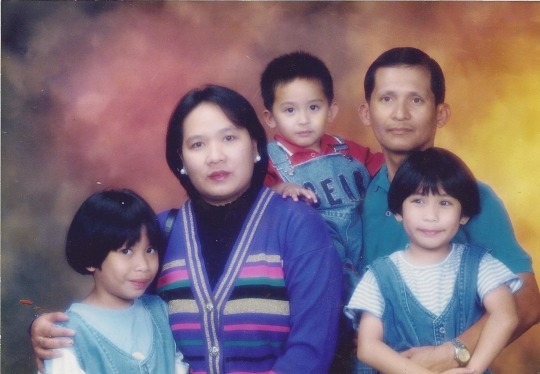
The last portrait of Giselle's family, taken on the day of their accident (Giselle is the child on the right, held by her father.) Photo provided by the artist.
Tell us about what you're currently working on or hope to create next.
I am immensely privileged that my husband and I managed to modify our financial circumstances so that I am not as pressured to find employment for the past seven months. I had unprecedented time and capacity, which is overwhelming. My current project is the memoir that I'm writing — my first literary project of this scale. It's a coming-of-age memoir from the day my parents and sister died to the day when I landed in Canada in August 2007. My plan is to have an artistically compelling work that will take readers on an adventure of a Filipina girl’s story growing up. And thanks to different resources that I managed to access in the past few months, the manuscript is developing well. I hope that people get to read it in the near future. The road to publication and promotion is exciting and I hope we get there soon! It will be a new experience to work with editors while finding a way to make a living – since my savings account is not unlimited.

A stack of primary source materials for Giselle's memoir. Photo provided by the artist.
Tell us about someone who has mentored you or helped set you on your path.
My husband is the first person who showed appreciation for a visual piece of art I made. That helped me integrate creative expression regularly into my life. Aside from that, I’m grateful for the different mentors and organizations I’ve encountered. I try reminding myself that I am worth it and that I can apply for these kinds of things. The Writers’ Guild of Alberta has a group called the Horizon Writers Circle for underrepresented writers like me. I was paired with a mentor, an author named Wendy McGrath. Her support and constructive feedback have been incredible during the six-month mentorship program.
I've been tapping into the Edmonton Arts Council. From the newsletters and being inspired by other people's stories to the recent, tangible piece of support: I received an Individuals & Collectives grant. The staff from the different arts funding organizations have been incredible in giving tangible knowledge to help me access more funding to help my artistic work become a reality.
Also, in Edmonton there’s the Philippine Arts Council, they're all volunteers. They've worked hard over the past few years to find ways to showcase the work of Filipino artists from online galleries, documentary programs, and building a community.

Photo provided by artist.
What does community mean to you? And where do you find it?
For me, community means that one-of-a-kind, remarkable ability to do good in the world that you can only do with the power of multiple people. Because they bring different perspectives, passions, and skills together. And if you find your group of people with whom you have something in common, the positive impact in the world that you can make is quite profound.
Where do I find it? Being an introvert (many don't believe that about me) I’m selective about the networks I build. I’ve found community many times online and with social media circles. I know it’s kind of a minefield, but Twitter can still be a treasure trove of people and wonderful opportunities to learn. Maybe it’s the immigrant in me, but I like to build community in places with a bit of formality. If there is a program or a workshop that I attend on a regular basis or when I’m assigned a role if I’m on a volunteer board, I’m happy and I find it rewarding to fulfill that task. As an extension of that, I build community with the people that I worked alongside.
What are some important lessons you’ve learned as a community advocate and an artist?
There are endless ways to make positive change happen. Being okay with trying new things and changing direction is very important. Also, having an open mind to incorporate other people's experiences that you haven't gone through. I try to have a good sense of my privileges and my points of marginalization. I'm a woman, I’m Asian, I'm an immigrant, I can't drive — that counts. Those are notable points of marginalization. At the same time, white people compliment me for my so-called perfect English. My verbal communication is mostly white-passing and my last and first name are white-passing, those are privileges too. I am straight and cisgender, able-bodied, and I'm not Indigenous, so I'm very conscientious of all of that. Being open-minded because there are points of hardship that I could never comprehend is important. And, at least for me, also being okay with not completely fitting in. Looking at all the things I’m involved in, I stand out even within ethnocultural organizations due to other criteria — whether it’s based on age, gender, country of origin, or my family circumstances.
I dislike labels and titles like VP Internal and Subcommittee Chair, writer, or artist. I think it's because I'm an action-oriented person. I prefer describing myself based on the tasks I do; I write columns for the ethnic paper; I write creative nonfiction; I salvage waste by upcycled materials for visual art. But I know that titles have a functional reason, so I put up with it!

A mixed-media artwork "Palit-pananamit" by Giselle General that was part of a Philippine Arts Council exhibition in 2022 for Filipino Heritage Month.
Tell us about an opportunity that you think more creatives should know about.
I wish more people were aware of funding opportunities. There’s the Edmonton Arts Council, there's also funding available through the Alberta Foundation for the Arts and the Canada Council for the Arts. I think it's really important that people understand that even if they have a job unrelated to the arts, but they have a creative idea that they want to make into a reality, there is funding for different purposes. They can apply for professional help, there's a category for education, even for buying or renting equipment and supplies.
In my case, I applied for subsistence. People can apply for a few months of living expenses while they do their work. I needed reassurance that I could cover my bills while I go through the ordeal of writing emotionally heavy content. It's been an adventure writing my memoir. It's important for the public to realize that you don't need to be a full-time artist or a born-and-raised Canadian or sophisticated, popular or whatever. Everyone is worth it. Their creative work is worth it. So please, apply for arts funding!
Yes, that is important to share since there are others who also might not necessarily see themselves as an artist, in that capacity at least. It can take a while to build yourself up to that.
Indeed! As someone considered the A student growing up, the people around me had lofty ambitions. But a lot of the time it had nothing to do with the arts, which is in many ways, unfortunate. In my case, ambitions are made more complicated with the immigrant dream. I have been here for almost half my life. I have a lot of complicated questions and emotions as far as “how do I demonstrate that my being brought over here is not a waste of anyone's time.” Franky, it’s confusing. There's a bit of survivor’s guilt too.
There's also the issue of visible representation. So, for my memoir or any other literary work, being a bestselling author is a minor objective. Access is more important. In addition to mainstream and indie bookstores, I want my book to be in the bookstores at airports so that when Filipinos are traveling all over the world, they can buy it. I want it to be available to borrow from every public library both in the Philippines and countries where there's a lot of the Filipino diaspora. Then as a spillover effect, people from other communities can access it, enjoy it, and understand someone with my story.
Listen to Giselle General tell her story on CBC Radio's Radio Active show! Aired March 9, 2023.
Want more YEG Arts Stories? We’ll be sharing them here and on social media using the hashtag #IamYegArts. Follow along! Click here to learn more about Giselle General.
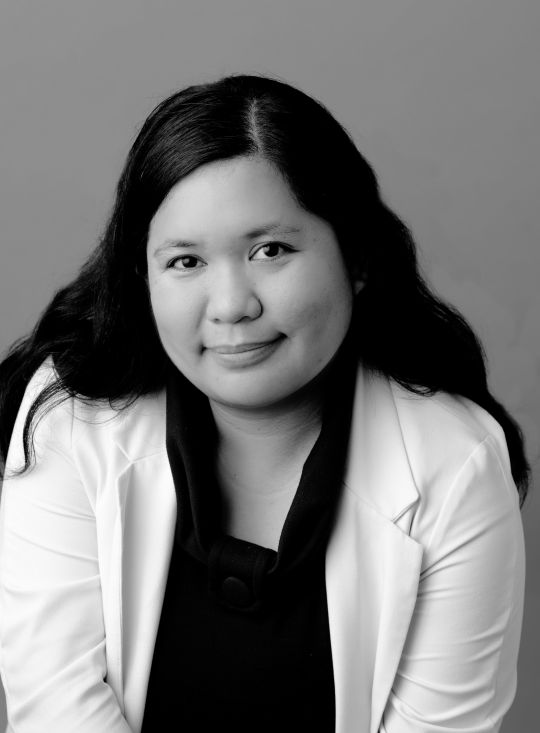
Photo of Giselle General by Sheila Bell, Edmonton Brand Photographers.
About Giselle General
Giselle General has worked in the non-profit sector for over a decade, most recently as the Volunteer and Events Coordinator for the Edmonton Community Legal Centre. She serves as the Chair of the Edmonton Transit Service Advisory Board, Program Director with the West Meadowlark Community League, Board Secretary of the Edmonton Multicultural Coalition, and a District Representative with the Edmonton Federation of Community Leagues. Giselle is a columnist for the Alberta Filipino Journal, a local ethnic paper in Edmonton. In the 2021 Edmonton Municipal Election, she placed second in the City Councillor race for Ward sipiwiyiniwak. Giselle has been featured by CBC, CTV, and Global Edmonton, as well as various local podcasts such as “What’s the Tsismis” and “The Broadcast.”
Giselle General immigrated to Canada at 16 years old. She and her younger brother were sponsored by relatives after they became orphans due to a vehicular accident killing their parents and sister. She completed a Bachelor of Commerce Degree from the University of Alberta School of Business. She enjoys volunteering, writing, sewing, and creating mixed-media artwork using recycled materials. She has self-published a book of poems, The Humanity in Me and writes for her blog, FilipinaYEG. Giselle lives with her husband Corey in Edmonton.
0 notes
Text
New public artwork documenting Indigenous relation to the land installed this week downtown

Sipikiskisiw (Remembers Far Back) by Michelle Sound. Archival photo and map on paper, embroidery thread, rick rack, vintage beads, bugle beads, glass seed beads, caribou tufting, porcupine quills.
Indigenous relation to the land in amiskwaciwâskahikan (Edmonton) is the subject of a new artwork, Sipikiskisiw (Remembers Far Back) by Michelle Sound, which is being installed this week at the Edmonton Transit Service (ETS) shelter located at 10020-100 Street NW. The transit shelter was recently renewed as the City of Edmonton works toward creating more safe, inclusive, and attractive public spaces for transit riders and the public.
Like Sound’s artwork often does, Sipikiskisiw (Remembers Far Back) explores her Cree and Métis identity from a personal experience rooted in family, place and history. Her artwork for the ETS shelter takes torn copies of archival images of an Indian Affairs Papaschase reserve survey map from 1899 and a photograph taken prior to 1907 of Indigenous men and tipis on the grounds of Fort Edmonton. The artist then mended the torn imagery using embroidery thread, caribou tufting, porcupine quills, and beadwork.
The rips in the images are meant to “show the colonial violence that Indigenous people have experienced, including residential schools, intergenerational trauma, loss of language, and displacement from our territories,” explains the artist in a written statement about the work. The mending of the images doesn’t fully obscure the rips, shares Sound, just as “the loss, grief, longing, and memory cannot be fully mended and the resiliency required to survive colonialism is also messy and fragile. These losses can never be fully healed but we can process our histories and realities through art, culture and stories.”

Sipikiskisiw (Remembers Far Back) by Michelle Sound is currently being installed at the ETS shelter located at 10020-100 Street NW
Commissioned in 2022 under the City of Edmonton’s new Public Art Policy, the Edmonton Arts Council worked with three local Indigenous artists/curators to select an artist for this project. Edmonton Arts Council's Public Art Director David Turnbull said of the new policy, “it allows us to be flexible, responsive, and use curatorially-driven approaches to intentionally grow and develop a public art collection that is high quality, accessible, relevant, and representative of Edmonton’s diverse communities.”
Last fall 2022 we asked one of the curators of ETS shelter project, Emily Riddle, to reflect on the process and the significance of the public artwork by Michelle Sound in a guest article for the YEGArts blog. Click here to read the article.
0 notes